Poland is home to a wide variety of birds, from rare species like the White-tailed Eagle to common garden visitors like the Chaffinch. These birds are an important part of the country’s natural heritage and are a delight to birdwatchers from around the world.
From the rugged Tatras Mountains to the lush Pomeranian Coast, Poland offers a natural paradise for its avian inhabitants, and its diverse habitats are home to a multitude of species.
This article provides an overview of the birds of Poland, including their habitats, behaviors, and conservation status.
1. Great Spotted Woodpecker
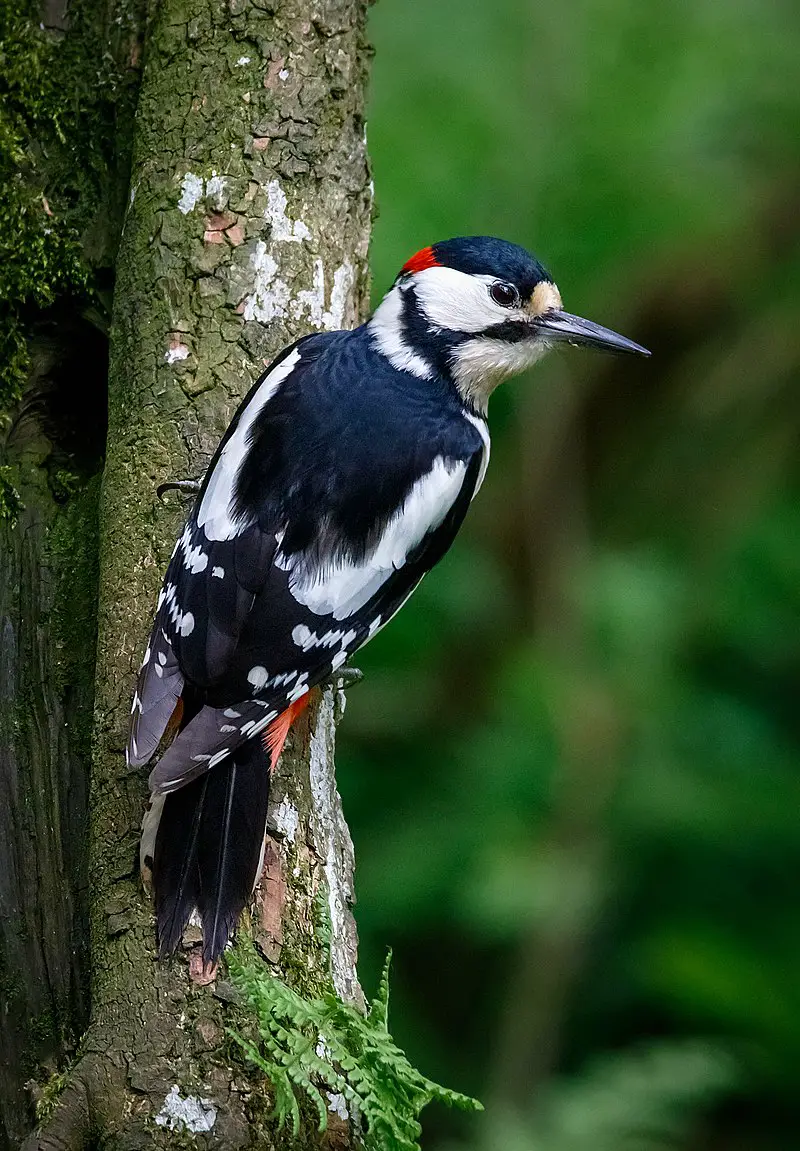
The Great Spotted Woodpecker is a fascinating bird. It has black and white feathers, with red patches on its lower belly and head or neck depending on whether it’s male or young.
This species inhabits most of the Palearctic region as well as some parts of North Africa.
For much of its range, it remains in one place all year round but may migrate if food sources become limited further north.
Its diet consists mainly of insects found under tree bark along with small amounts of seeds and fruit when available.
Despite being quite vocal they are hard to spot due to their camouflaged feathers which helps protect them from predators like cats and birds-of-prey.
Scientific classification:
| Kingdom | Animalia |
| Phylum | Chordata |
| Class | Aves |
| Order | Piciformes |
| Family | Picidae |
| Genus | Dendrocopos |
| Species | D. major |
2. Common Wood Pigeon
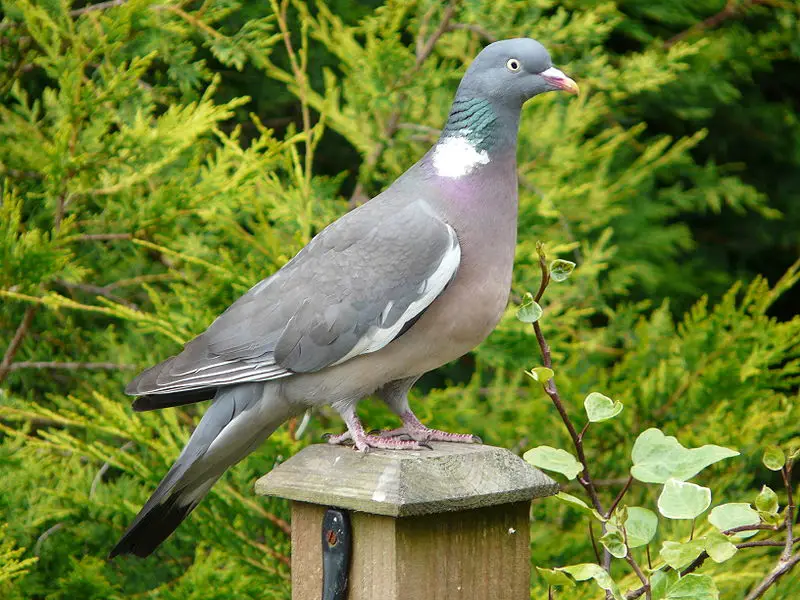
The Common Wood Pigeon is a large bird of the dove and pigeon family, native to the western Palearctic. It has grey plumage with white patches on its wings and neck.
Its head often appears darker than its body due to iridescence in some parts of its feathers. The male woodpigeons have pinkish breasts while females are more brownish-grey coloured.
These birds feed mainly on seeds, fruits, flowers and leaves but will also eat insects when available.
They breed during springtime producing 1-2 clutches per breeding season with two eggs each time which hatch after about 18 days incubation period by both parents taking turns for duty.
They make their nests from twigs collected from nearby trees or places close by and usually raise only one brood at a time making them an important part of nature’s balance as they help keep insect populations under control through their diet choices.
Scientific classification:
| Kingdom | Animalia |
| Phylum | Chordata |
| Class | Aves |
| Order | Columbiformes |
| Family | Columbidae |
| Genus | Columba |
| Species | C. palumbus |
3. European Green Woodpecker
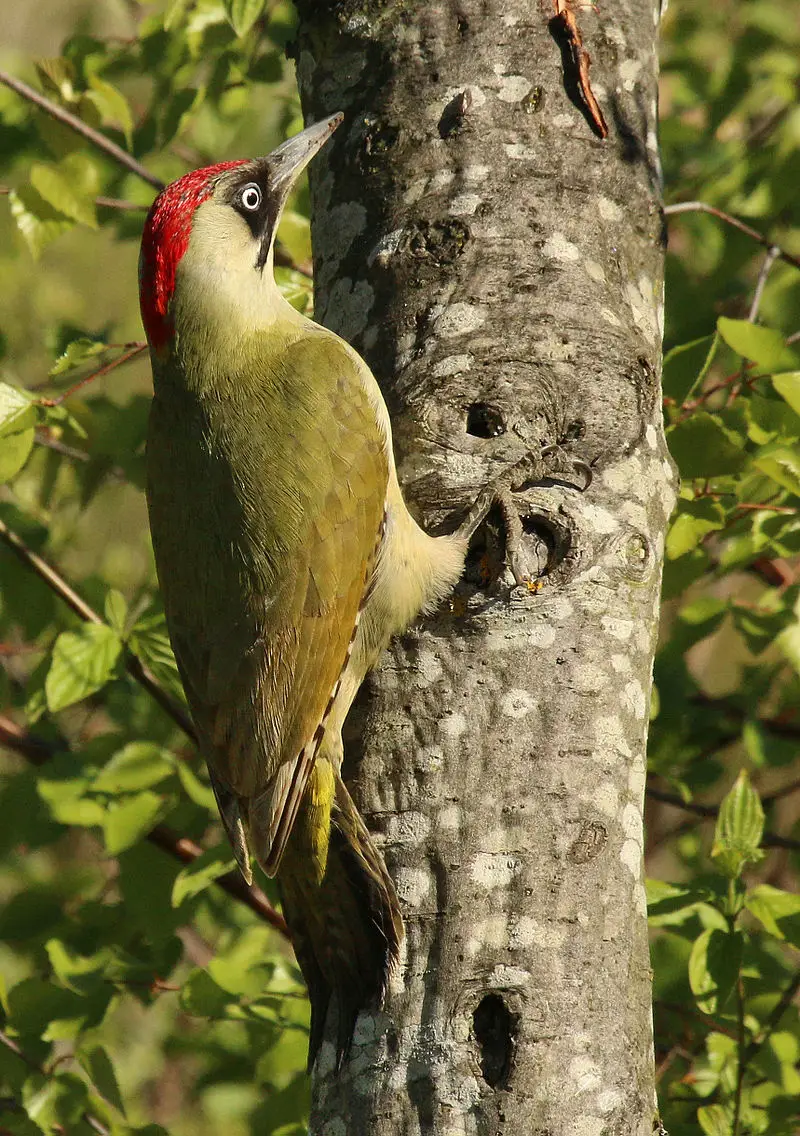
The European green woodpecker is a vibrant species with striking features. The body has an emerald hue, while males have a red crown and black moustache that extends to the middle of their forehead.
Females lack this characteristic feature but instead possess barred markings beneath the wings as well as yellow throats and cheeks.
It can be found in many parts of Europe and western Palearctic regions such as Spain and Portugal where it is replaced by its similar cousin; Iberian green woodpecker (Picus sharpei).
This bird loves inhabiting open forests or grasslands for its food source which typically consists on insects like ants, beetles, spiders among others.
Its powerful bill allows it to dig into tree bark searching for larvae underneath making it an efficient predator in these environments.
Scientific classification:
| Kingdom | Animalia |
| Phylum | Chordata |
| Class | Aves |
| Order | Piciformes |
| Family | Picidae |
| Genus | Picus |
| Species | P. viridis |
4. White Stork
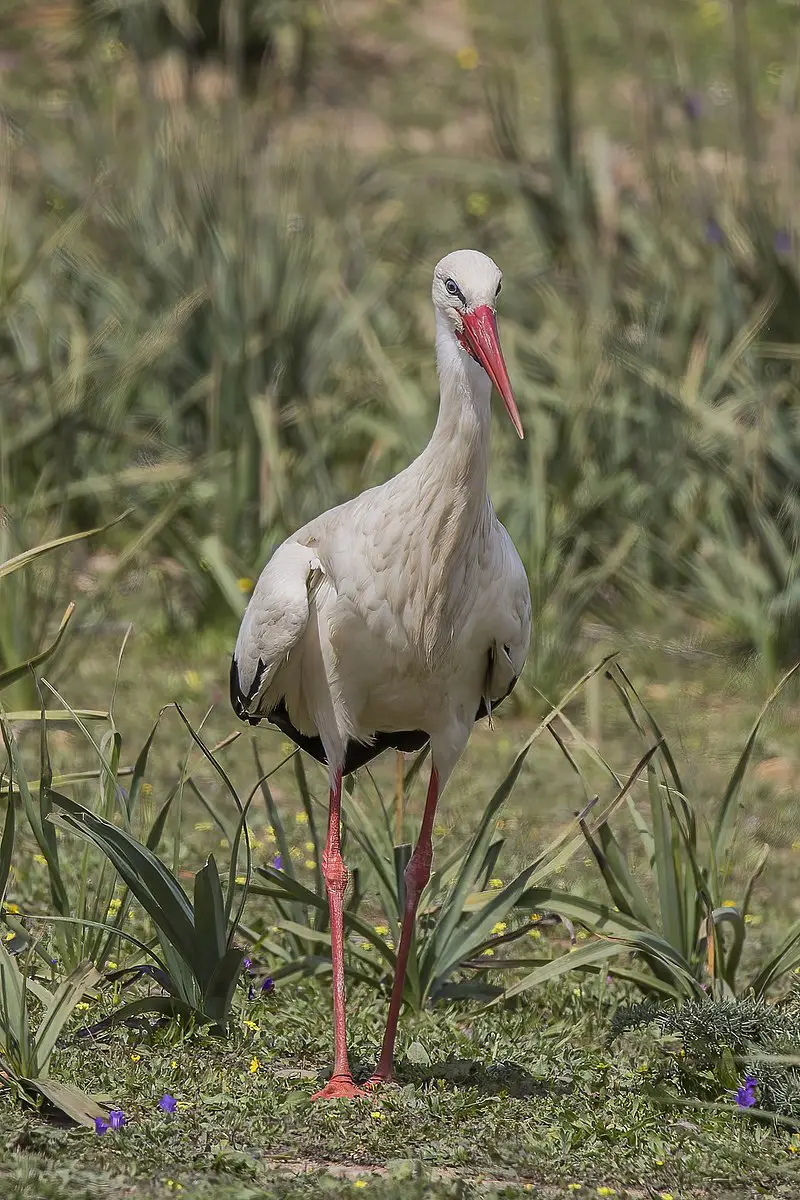
The White Stork is a majestic bird found in Europe, with white plumage and black wings. It has long slender legs and beaks that are usually bright red in color.
The average adult stands around 100 – 115 cm tall from beak to tail tip, while its wing span can reach up to 155-215 cm wide. There are two subspecies of the White Stork which differ slightly by size.
They feed on small animals such as frogs, fish or insects and nest near human dwellings due to the abundance of food available there; they also build nests atop chimneys or roofs when given the chance.
These birds have been revered for centuries as symbols of fertility because their return each spring often coincides with an increase in births among humans living nearby – something superstitious people take great note of.
Scientific classification:
| Kingdom | Animalia |
| Phylum | Chordata |
| Class | Aves |
| Order | Ciconiiformes |
| Family | Ciconiidae |
| Genus | Ciconia |
| Species | C. ciconia |
5. Black Woodpecker
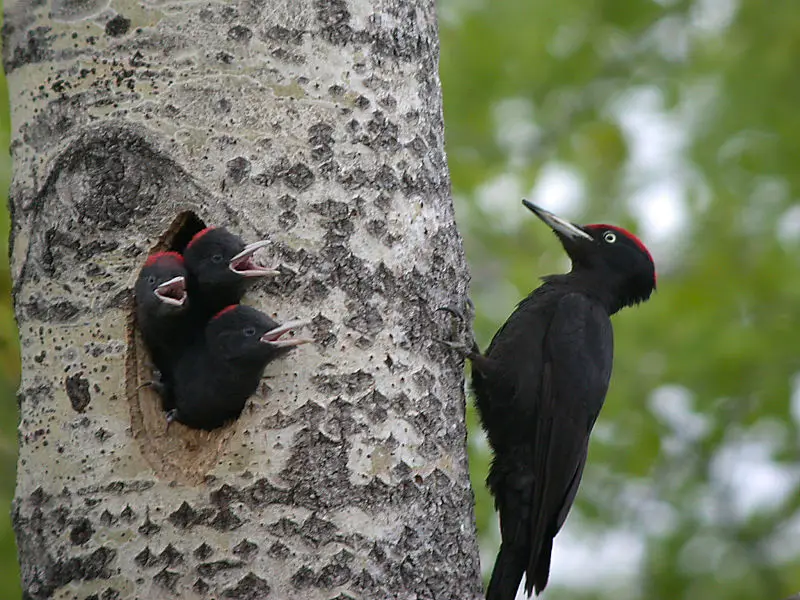
The black woodpecker is an impressive bird found in mature forests across the northern Palearctic region.
It stands out from other species due to its large size and striking black feathers with white spotting on their wings and tail.
Not only is it one of the largest woodpecker species worldwide but also, interestingly, appears to be expanding its range in Europe and Asia as well.
This non-migratory bird loves spending time amongst trees where they can feed off insects which live within tree trunks or branches; tapping away at them with their strong bills until they get a meal.
Scientific classification:
| Kingdom | Animalia |
| Phylum | Chordata |
| Class | Aves |
| Order | Piciformes |
| Family | Picidae |
| Genus | Dryocopus |
| Species | D. martius |
6. Middle Spotted Woodpecker
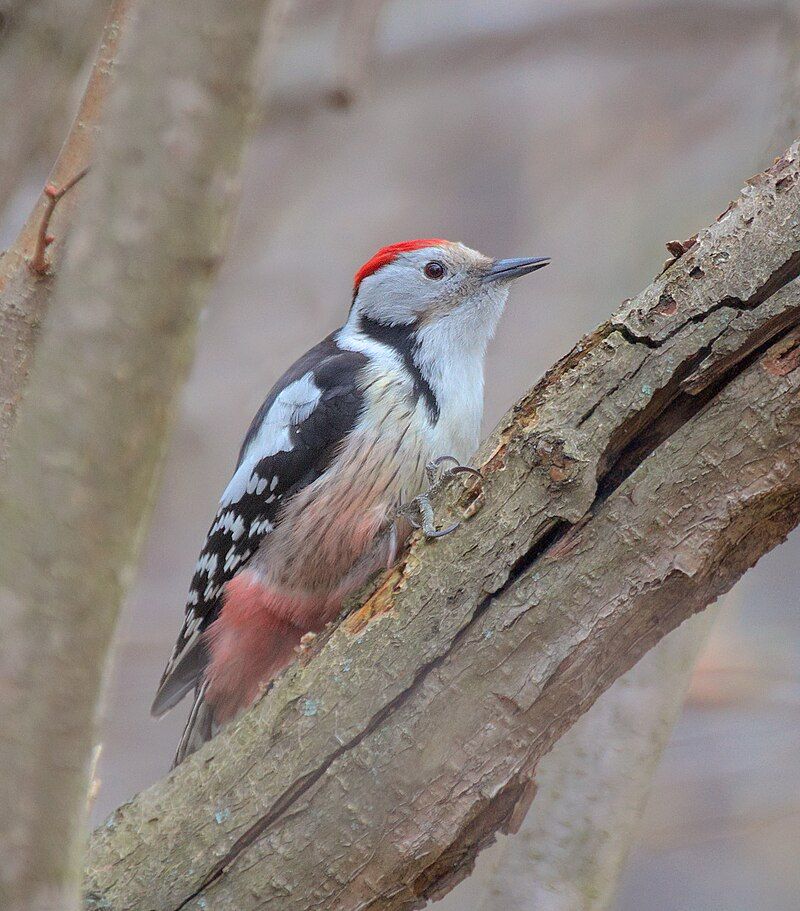
The Middle Spotted Woodpecker is a species of woodpecker native to Europe. It was formally described by the Swedish naturalist Carl Linnaeus in 1758 and given the binomial name Picus medius, with “medius” meaning intermediate – referring to its size compared to other woodpeckers.
They have black-and-white plumage with a distinctive red patch on their crowns, and are usually found around woodland areas where they feed on insects such as ants and beetles.
The males make loud drumming noises during mating season which can be heard for up to 500 meters away.
These birds generally live in tree cavities but will also nest inside old walls or buildings if available.
Conservation efforts are underway across Europe due to decreasing populations caused by habitat loss and fragmentation from human activity, making it an important species worth protecting.
Scientific classification:
| Kingdom | Animalia |
| Phylum | Chordata |
| Class | Aves |
| Order | Piciformes |
| Family | Picidae |
| Genus | Dendrocoptes |
| Species | D. medius |
Also Featured In: Birds Found in Hungary, Common Slovakian Birds
7. Black Stork
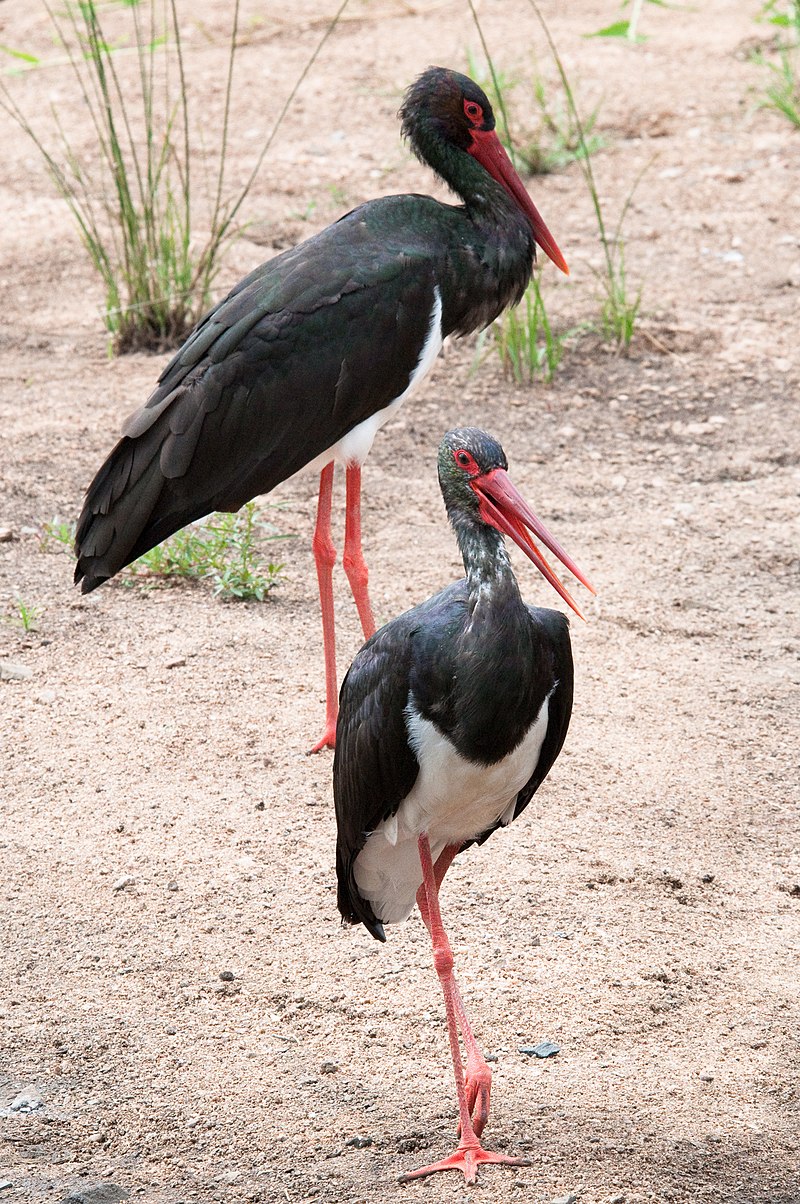
The Black Stork is a majestic bird, with its glossy black feathers and long red legs. Its wingspan ranges from 57 to 61 inches, while it measures an average of 37 to 39 inches tall from beak tip to tail end.
The white underparts contrast perfectly against the dark plumage and are complimented by the vivid red beak.
First described in 1758 by Carl Linnaeus in his “Systema Naturae”, this species has since become popular among bird watchers and naturalists alike for its beauty and gracefulness when flying through the sky.
Scientific classification:
| Kingdom | Animalia |
| Phylum | Chordata |
| Class | Aves |
| Order | Ciconiiformes |
| Family | Ciconiidae |
| Genus | Ciconia |
| Species | C. nigra |
8. Great Tit
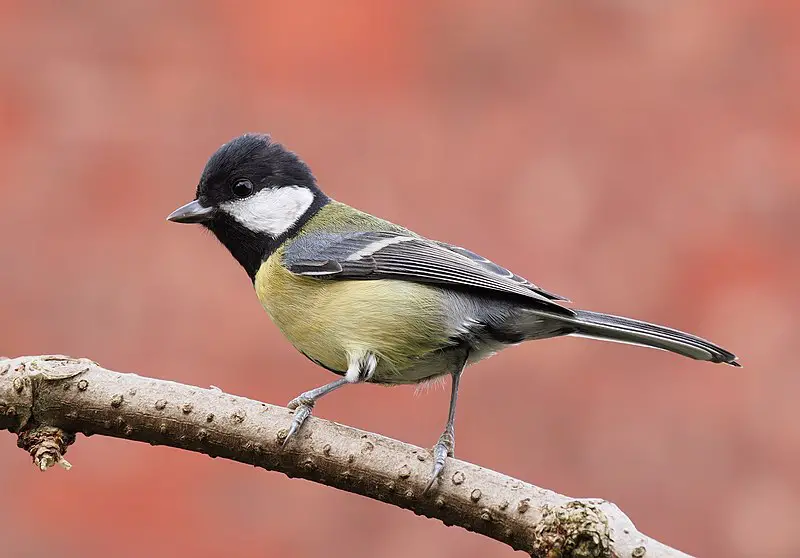
The Great Tit is a small passerine bird found in woodlands throughout Europe, the Middle East and Central Asia. Its beautiful black and white plumage with bold yellow or green patches make it easily distinguishable from other species of its family.
It generally does not migrate except for harsh winters but will stay resident in any kind of woodland area.
The diet consists mainly on insects, seeds and nuts which are found by searching through trees or scavenging from feeders placed near gardens.
Great Tits are also known to be clever problem solvers; they can open milk bottles left out unattended as well as cracking sunflower seeds that provide them essential nutrients during winter months when food is scarce.
Scientific classification:
| Kingdom | Animalia |
| Phylum | Chordata |
| Class | Aves |
| Order | Passeriformes |
| Family | Paridae |
| Genus | Parus |
| Species | P. major |
9. Crow Family
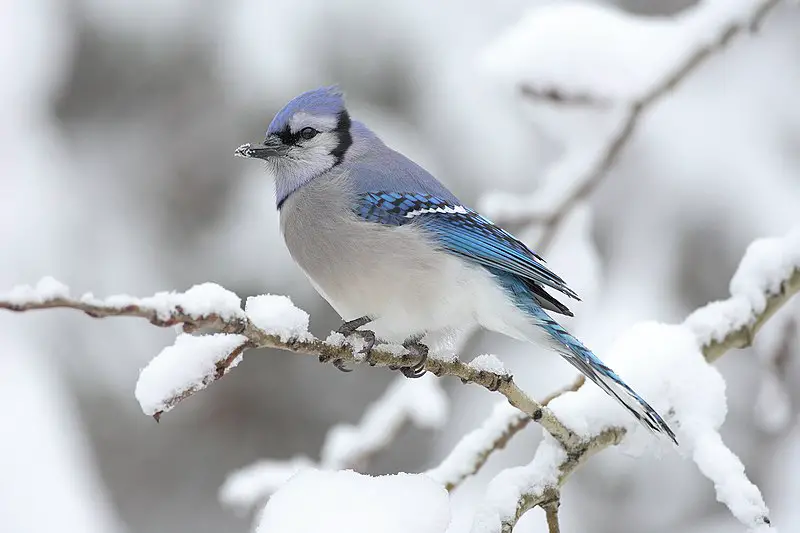
The Crow family is a cosmopolitan group of birds that contains crows, ravens, rooks, jackdaws, jays, magpies and more.
Altogether there are 133 members in this bird family which all share similar characteristics such as large beaks and feet.
The genus Corvus alone makes up over a third of the entire crow family population with species like the common crow or blackbird being some of its most recognizable members.
All these birds have strong social bonds so they often travel in groups to find food sources or build nests together for protection against predators.
With their intelligence and adaptation skills they are able to survive almost anywhere on Earth from mountains to cities making them one of the world’s most successful families of avian creatures.
Scientific classification:
| Kingdom | Animalia |
| Phylum | Chordata |
| Class | Aves |
| Order | Passeriformes |
| Superfamily | Corvoidea |
| Family | Corvidae Leach, 1820 |
10. Little Owl
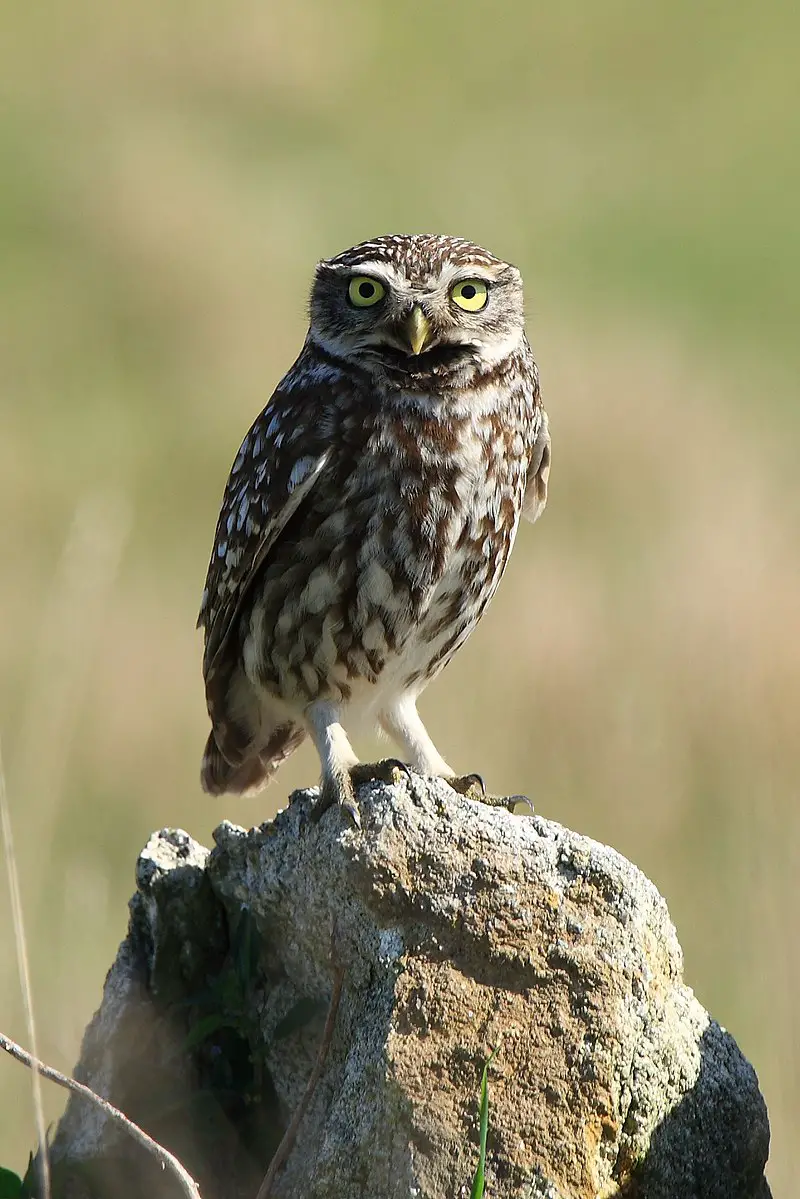
The Little Owl is a fascinating bird that inhabits much of the temperate and warmer parts of Europe, East Asia and North Africa. It’s also known as the “Owl of Athena” or “Owl of Minerva”.
This species was introduced to Britain in late 19th century and New Zealand’s South Island during early 20th century.
They belong to Strigidae family which are true owls with small bodies but large heads along with big eyes that helps them spot prey at night.
These birds feed on insects, earthworms, rodents like mice etc., making them beneficial for controlling pests around agricultural lands.
Besides these benefits they have become an important part in folklore associated with wisdom and knowledge over years due their silent presence near human dwellings after dark hours.
Scientific classification:
| Kingdom | Animalia |
| Phylum | Chordata |
| Class | Aves |
| Order | Strigiformes |
| Family | Strigidae |
| Genus | Athene |
| Species | A. noctua |
11. Black Grouse
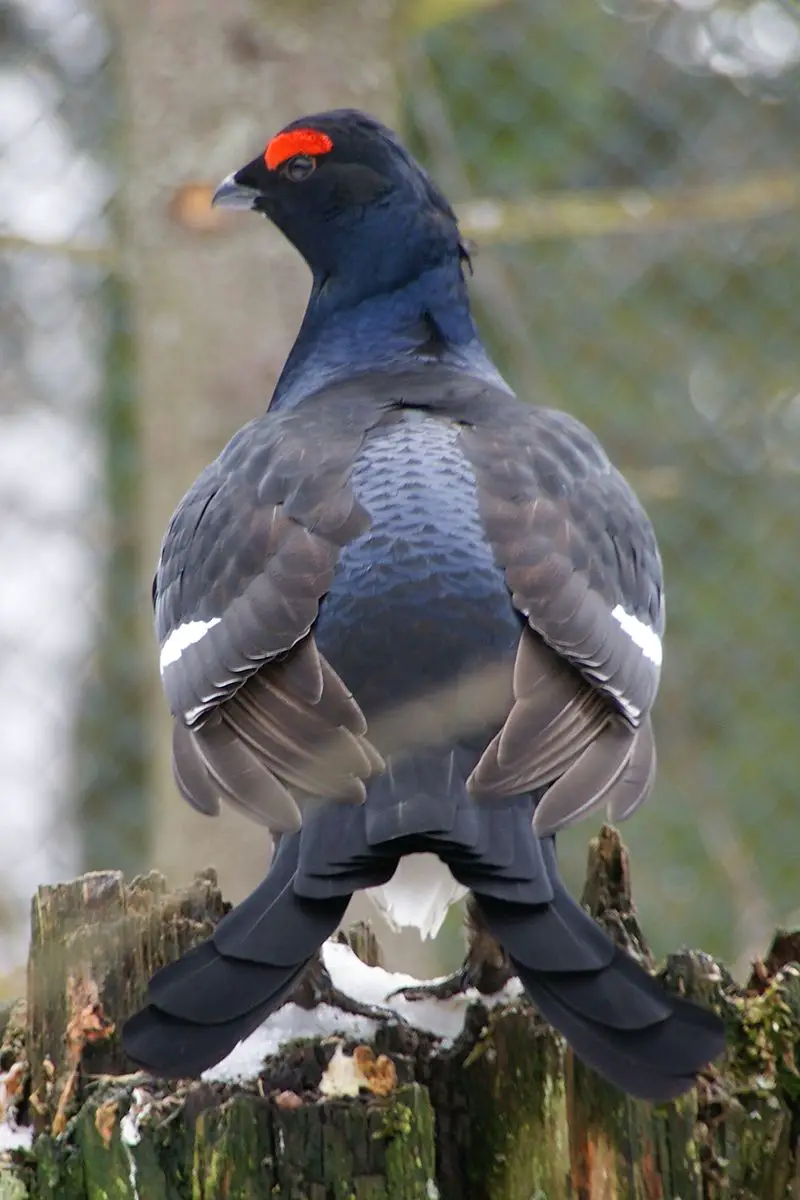
The black grouse is a large bird in the grouse family. It lives mainly in moorland and steppe habitats, often near wooded areas. In winter, it moves to dense forests where its diet consists almost exclusively of conifer needles.
These birds have an impressive wingspan of up to 75 cm wide, with males boasting dark metallic plumage and white tail feathers that they display during courtship rituals known as ‘leks’. Females are smaller than males with more brownish-grey coloured feathers.
Both sexes possess red combs above their eyes which become brighter during mating season – along with yellow wattles on their throats.
The black grouse is considered vulnerable due to loss of habitat caused by human activity such as deforestation and agricultural practices.
Scientific classification:
| Kingdom | Animalia |
| Phylum | Chordata |
| Class | Aves |
| Order | Galliformes |
| Family | Phasianidae |
| Genus | Lyrurus |
| Species | L. tetrix |
12. Western Capercaillie
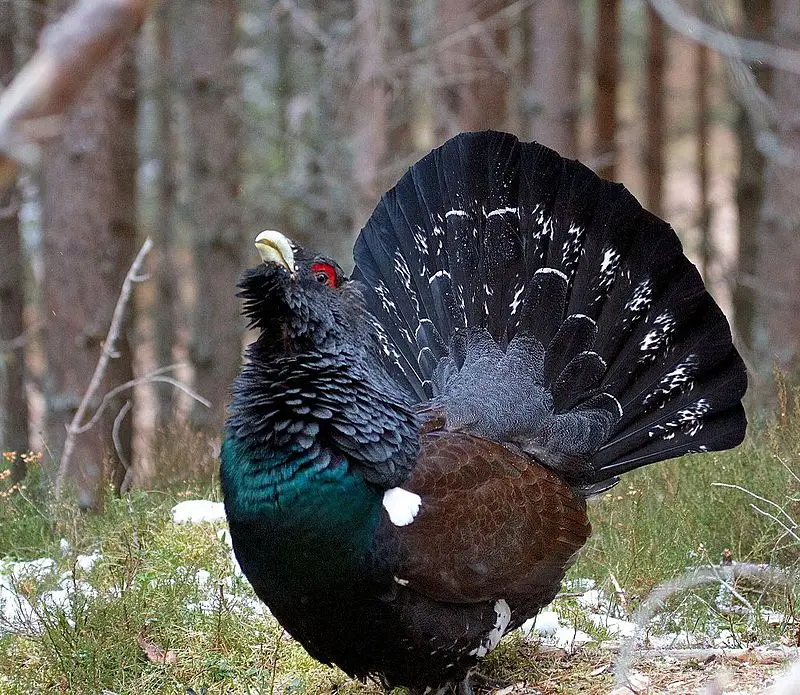
The Western Capercaillie is the largest bird among all grouse species. It has a wingspan of around 2 to 3 feet and can weigh up to 16 pounds. Its body is covered in rich, dark brown feathers which have light speckles throughout them.
This beautiful bird inhabits parts of Europe and the Palearctic region where it feeds on berries, seeds and buds from trees like birch and pine.
In winter months they’ll also eat mushrooms when available too. They live in forests with plenty of dense vegetation so that they can hide away from predators when necessary.
During mating season males will perform elaborate courtship displays to attract females – making this one amazing creature indeed.
Scientific classification:
| Kingdom | Animalia |
| Phylum | Chordata |
| Class | Aves |
| Order | Galliformes |
| Family | Phasianidae |
| Genus | Tetrao |
| Species | T. urogallus |
Also Featured In: Italian Birds You Should Know, Belarus Birds You Should Know
13. Long-Tailed Tit
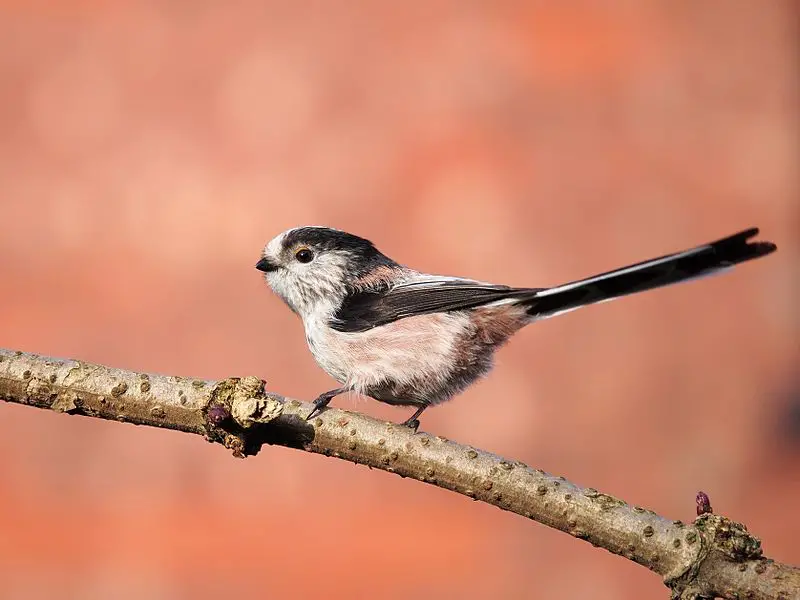
The Long-tailed tit is a common bird found throughout Europe and the Palearctic. Described by Carl Linnaeus in 1758, it has been given the scientific name Aegithalos caudatus which translates to “long tailed bush-tit”.
These birds are small with white bellies and grey backs. The distinguishing feature of this species is its long tail feathers which give them their name.
They feed on insects such as moths, flies and spiders but also eat seeds from plants like thistles or dandelions.
In cold weather they flock together for warmth while at night they roost inside woodpecker holes or other crevices in trees.
Long-tailed tits build intricately woven nests made of mosses, lichens, spider webs and fur held together by saliva – these can be up to 15 cm wide.
Scientific classification:
| Kingdom | Animalia |
| Phylum | Chordata |
| Class | Aves |
| Order | Passeriformes |
| Family | Aegithalidae |
| Genus | Aegithalos |
| Species | A. caudatus |
14. European Roller

The European roller is a beautiful bird belonging to the Coracias family, and it’s the only one of its kind found in Europe.
It inhabits various habitats such as dry wooded savanna, bushy plains and other areas except for treeless ones.
During wintertime they usually nest in tree holes, while their range extends into Middle East, Central Asia and Maghreb regions.
They have vibrant blue feathers with black stripes along the neck area which makes them stand out from other birds easily.
Its diet consists mainly of insects like grasshoppers or beetles that are hunted by catching them mid-air during flight; this feature adds an extra charm to these magnificent creatures.
Scientific classification:
| Kingdom | Animalia |
| Phylum | Chordata |
| Class | Aves |
| Order | Coraciiformes |
| Family | Coraciidae |
| Genus | Coracias |
| Species | C. garrulus |
15. Eurasian Eagle-Owl
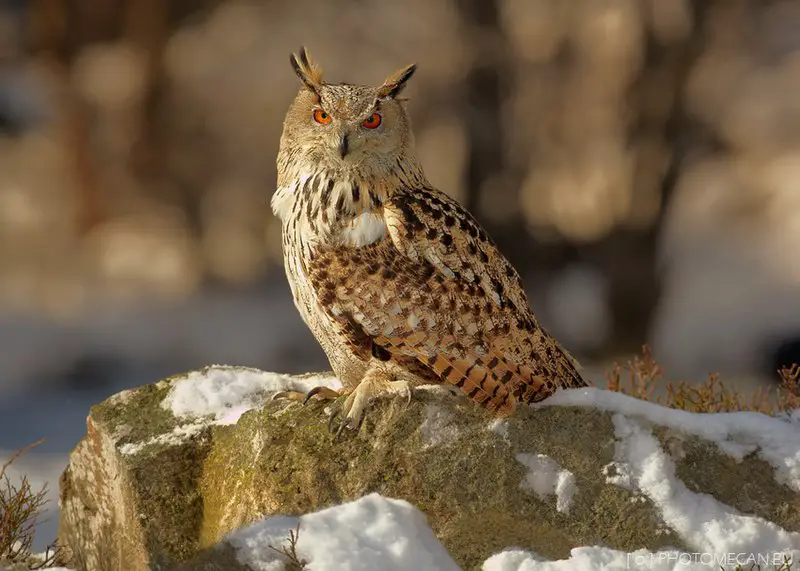
The Eurasian eagle-owl is a majestic bird that inhabits much of Eurasia. It has an impressive wingspan of up to 6 ft 2 in, and females can reach lengths of 30 inches.
The Uhu, as it is sometimes called, boasts distinctive ear tufts which are easily visible against its mottled brown plumage.
This powerful owl preys on small mammals like rodents and hares; however due to their large size they have been known to hunt larger prey such as foxes or even deer.
They usually nest in cavities located high off the ground but will also use manmade structures if available.
With their prominent presence across Europe, these birds are often seen perched atop trees during the day before setting out for hunting at night – truly magnificent creatures.
Scientific classification:
| Kingdom | Animalia |
| Phylum | Chordata |
| Class | Aves |
| Order | Strigiformes |
| Family | Strigidae |
| Genus | Bubo |
| Species | B. bubo |
16. Short-Eared Owl
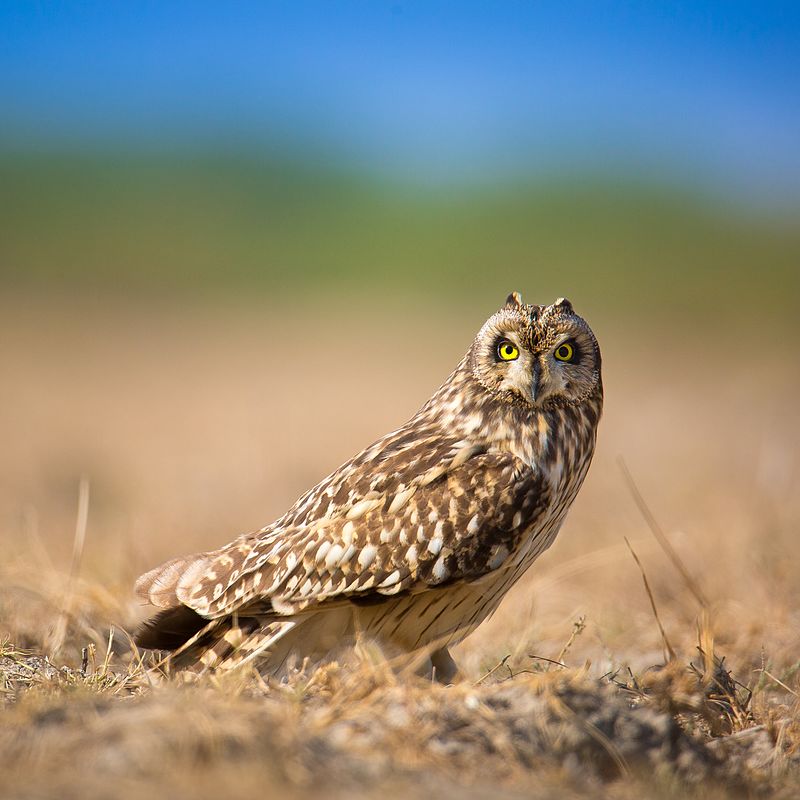
The Short-eared Owl is a species of owl belonging to the genus Asio, commonly known as ‘Eared Owls’. It has short tufts resembling mammalian ears that may or may not be visible.
When threatened they will display their tufts defensively; however these very short tufts are usually hard to spot.
This bird can be found in grassland habitats across much of the world and hunt mainly small mammals such as voles at night by swooping low over the ground from perches like trees and posts.
They also take other prey including birds, amphibians, reptiles and insects when available.
During breeding season males can often been seen performing aerial displays with claps of its wings while hovering above potential mates on territories it defends fiercely against intruders including humans.
Scientific classification:
| Kingdom | Animalia |
| Phylum | Chordata |
| Class | Aves |
| Order | Strigiformes |
| Family | Strigidae |
| Genus | Asio |
| Species | A. flammeus |
17. Boreal Owl
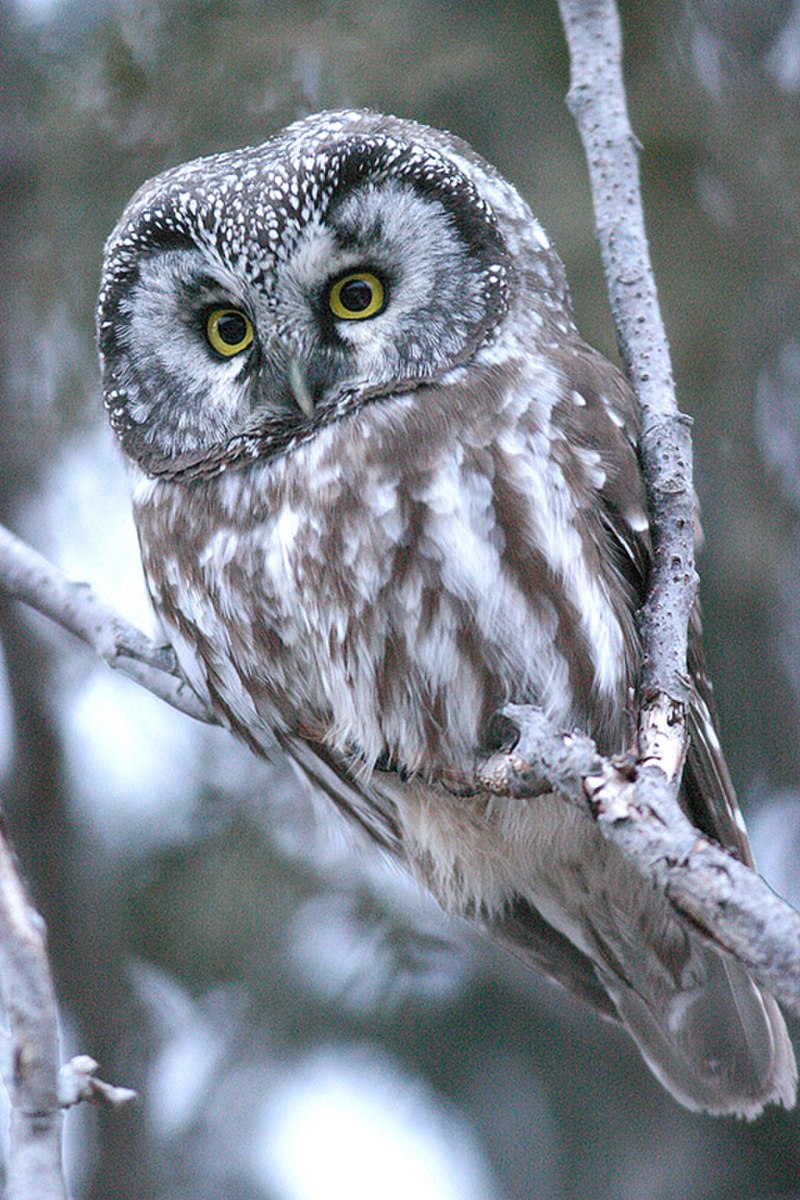
The Boreal Owl is a small, nocturnal bird of the Strigidae family commonly found in North America and Europe.
It’s also known as Tengmalm’s owl after Swedish naturalist Peter Gustaf Tengmalm or Richardson’s owl after Sir John Richardson.
The boreal owl has an elusive nature which makes it difficult to observe due to its shyness towards human activity during daylight hours.
Its feathers are dark brown with white spots on the wings, face and throat while its underbelly is light grey/brown with darker streaks along the sides.
They have long talons used for catching prey such as mice, voles and other small rodents making them effective hunters at night-time when they become more active seeking food sources away from humans.
Their habitat consists of coniferous forests where they can find shelter among large trees that offer nesting sites high up off of ground level keeping them safe from predators like foxes and coyotes who roam around looking for easy meals near the forest floor.
Scientific classification:
| Kingdom | Animalia |
| Phylum | Chordata |
| Class | Aves |
| Order | Strigiformes |
| Family | Strigidae |
| Genus | Aegolius |
| Species | A. funereus |
Also Featured In: Common Serbian Birds, Most Common Lithuanian Birds
18. Syrian Woodpecker
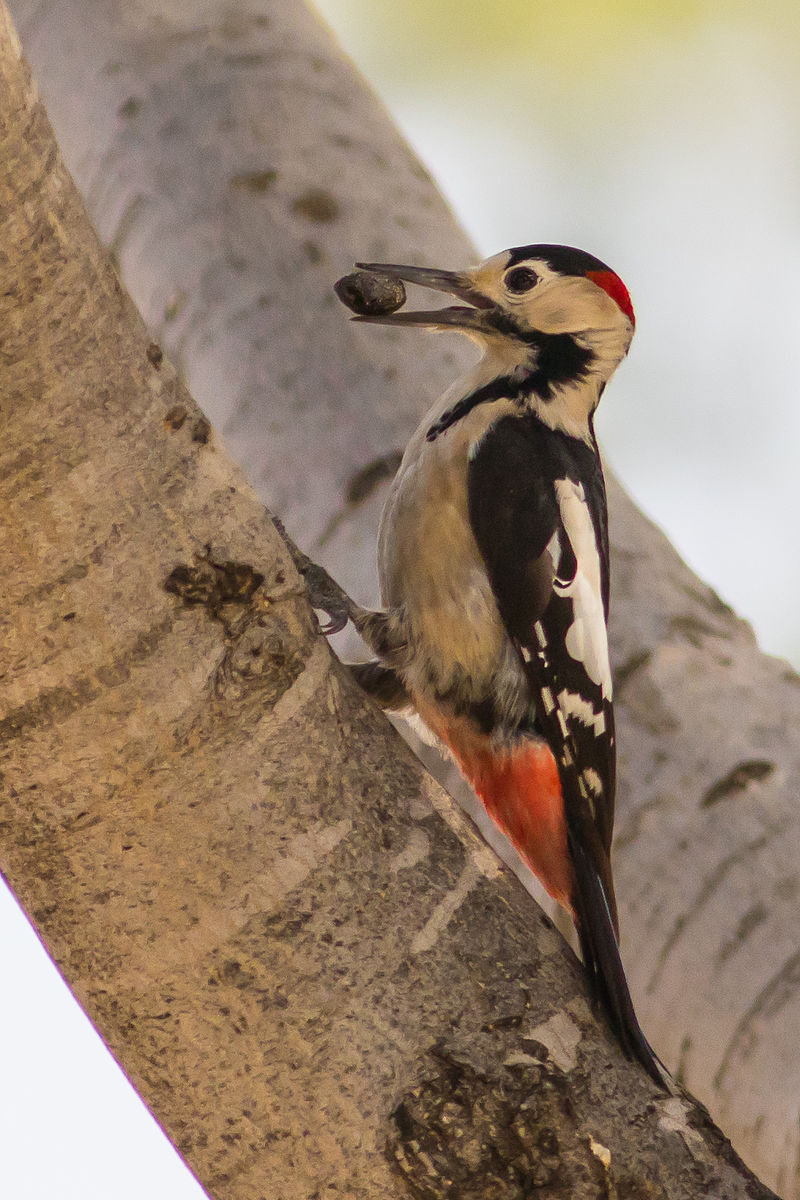
The Syrian woodpecker is a species of the Picidae family, first described in 1833 by Wilhelm Hemprich and Christian Gottfried Ehrenberg.
It resides throughout southeastern Europe to Iran and has recently expanded its range into northwest Europe.
This bird usually breeds in woodland areas with plenty of dead trees for it to feed on insects inhabiting them.
Its most distinguishing features include an olive-green back and black wings; white feathers line the sides while red covers its head crown down to its nape.
They are characterized as being highly vocal birds, often making loud tapping noises when searching for food under tree bark or branches.
The Syrian Woodpecker is a delightful addition to any avian landscape.
Scientific classification:
| Kingdom | Animalia |
| Phylum | Chordata |
| Class | Aves |
| Order | Piciformes |
| Family | Picidae |
| Genus | Dendrocopos |
| Species | D. syriacus |
Also Featured In: Syrian Birds You Need to Know, Armenian Birds You Should Know
19. Common Crane
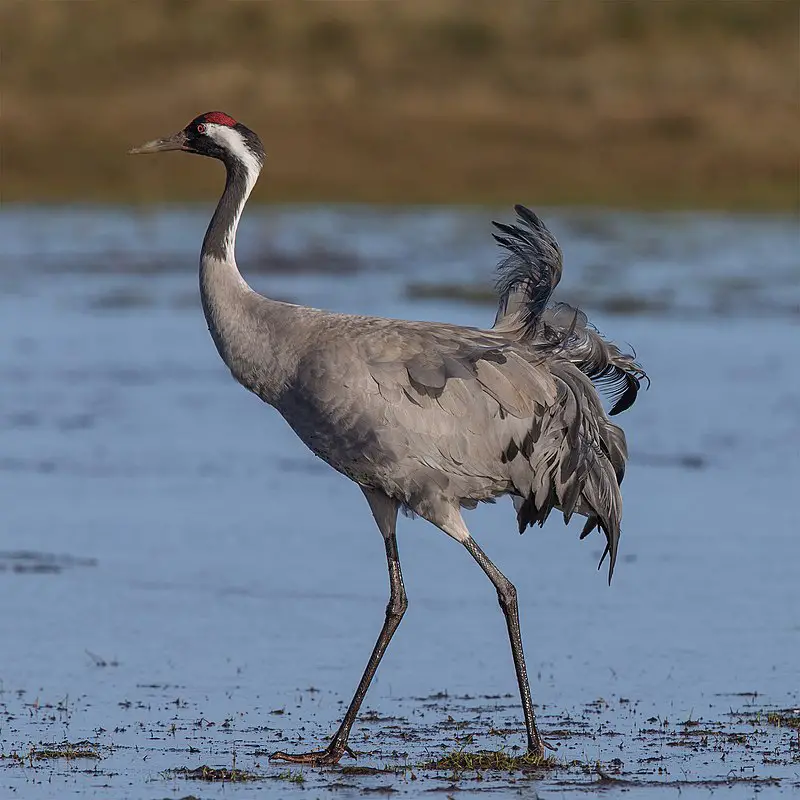
The Common Crane is a beautiful bird with grey plumage and white feathers on its head, neck and wings. It stands up to 1m tall and has a wingspan of around 2m.
This species is found in Europe as well as parts of Asia, Africa and the Middle East. Their diet consists mainly of plants such as grasses, grains, insects and small invertebrates like worms or molluscs.
The crane typically forages by walking slowly through fields looking for food items that it can pick out from the ground using its long beak.
During breeding season they gather together in large flocks which are an impressive sight to behold.
These birds have been known to live up to 25 years in captivity; however their lifespan is likely shorter when living wild due to predation risk from eagles or foxes amongst other threats.
Scientific classification:
| Kingdom | Animalia |
| Phylum | Chordata |
| Class | Aves |
| Order | Gruiformes |
| Family | Gruidae |
| Genus | Grus |
| Species | G. grus |
20. Tit
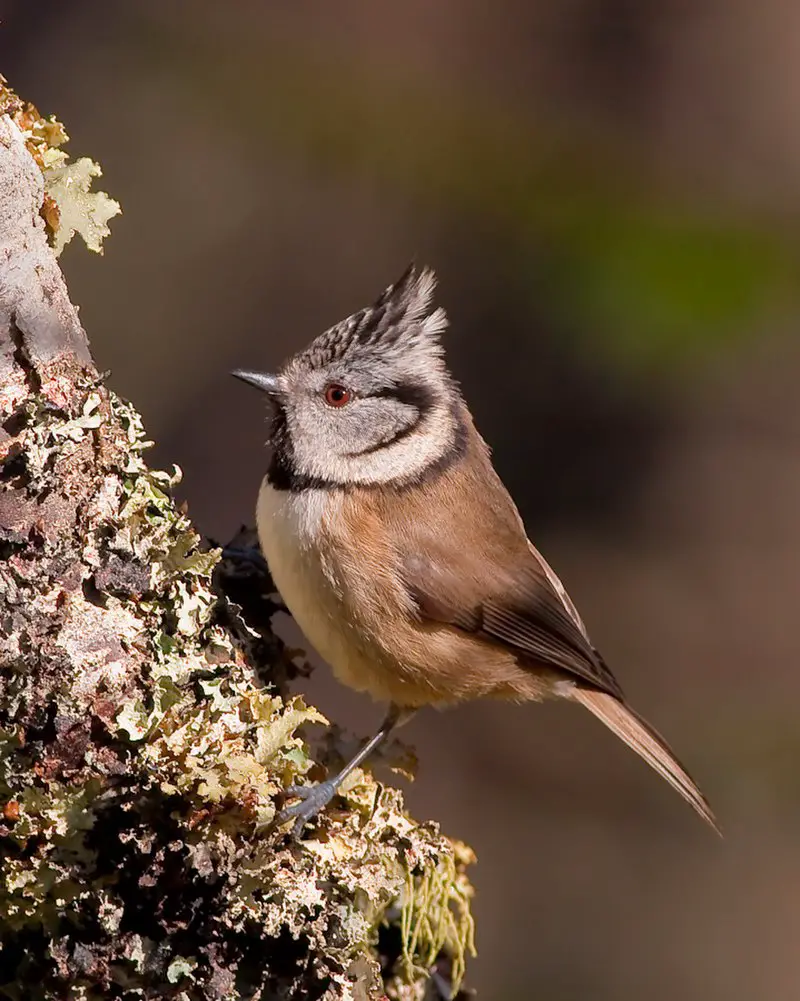
Tit birds are small passerine birds belonging to the family Paridae, found mainly in Northern Hemisphere and Africa.
These active little birds can be seen singing sweet songs throughout the day or scavenging for food at feeders.
They have short, stout bills which they use to crack open seeds and nuts with ease. Tit species range from chickadees to titmice; all of them sport a distinctive black head cap that stands out against their pale grey bodies.
Their bright eyes allow them excellent vision while searching for food – even on gloomy days when other predators may not see as well.
Tits are an important part of any healthy ecosystem and provide many ecological services such as insect control and seed dispersal.
Scientific classification:
| Kingdom | Animalia |
| Phylum | Chordata |
| Class | Aves |
| Order | Passeriformes |
| Infraorder | Passerida |
| Family | Paridae Vigors, 1825 |
21. Marsh Tit
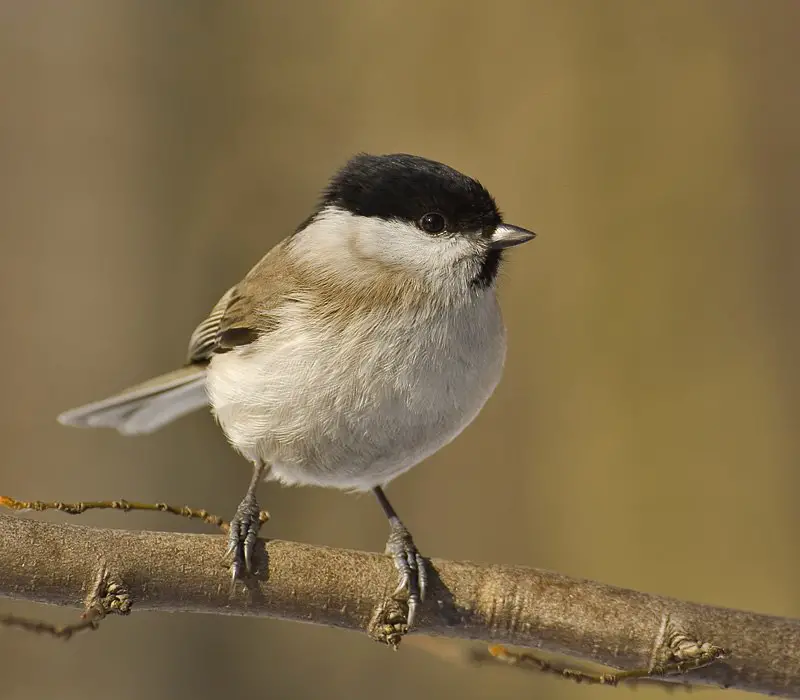
The Marsh Tit is a small bird, measuring 12 cm long and weighing only 12 g. It has black crown and nape combined with pale cheeks, brown back as well as greyish-brown wings and tail.
There are 8 to 11 subspecies of this passerine bird in the tit family Paridae that is closely related to Willow Tit, Père David’s Tit, Songar Tits.
They inhabit deciduous or mixed woods with dense undergrowth where they feed on insects along with seeds found amongst dead leaves on ground.
Their nests are built inside tree hollows lined up by feathers while its eggs have white background spotted heavily with reddish-brown markings making them easily identifiable from other birds’.
Scientific classification:
| Kingdom | Animalia |
| Phylum | Chordata |
| Class | Aves |
| Order | Passeriformes |
| Family | Paridae |
| Genus | Poecile |
| Species | P. palustris |
22. Eurasian Blue Tit
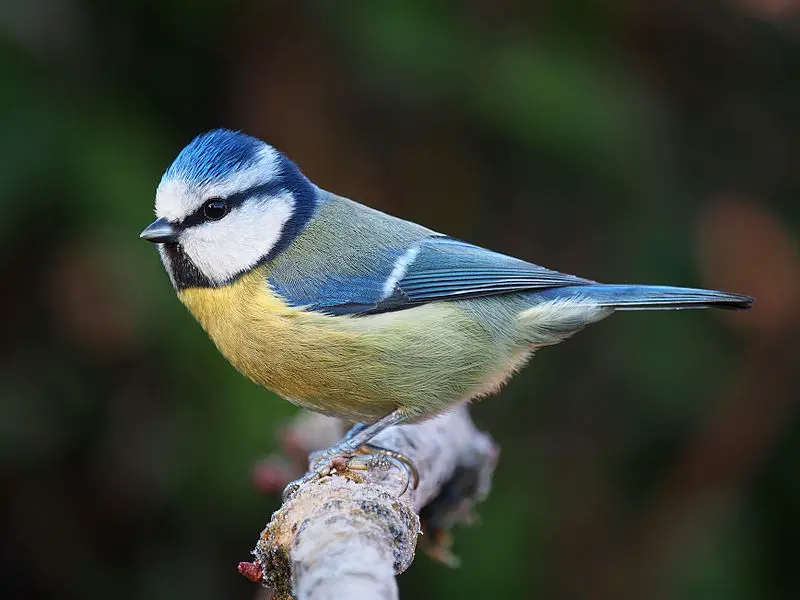
The Eurasian blue tit is a small passerine bird belonging to the Paridae family. Its bright blue and yellow plumage makes it easily recognizable, along with its small size.
They are usually resident birds that do not migrate, living throughout temperate or subarctic Europe and western Palearctic in deciduous woodlands.
These birds breed year-round and are common residents of these areas.
Their diet consists mainly of insects but they also feed on seeds during winter months when insects become scarce.
They can be found both alone or in pairs searching for food amongst trees branches, shrubs, grasses as well as visiting gardens for supplementary food sources such as peanut feeders provided by garden owners.
Scientific classification:
| Kingdom | Animalia |
| Phylum | Chordata |
| Class | Aves |
| Order | Passeriformes |
| Family | Paridae |
| Genus | Cyanistes |
| Species | C. caeruleus |
23. Eurasian Pygmy Owl
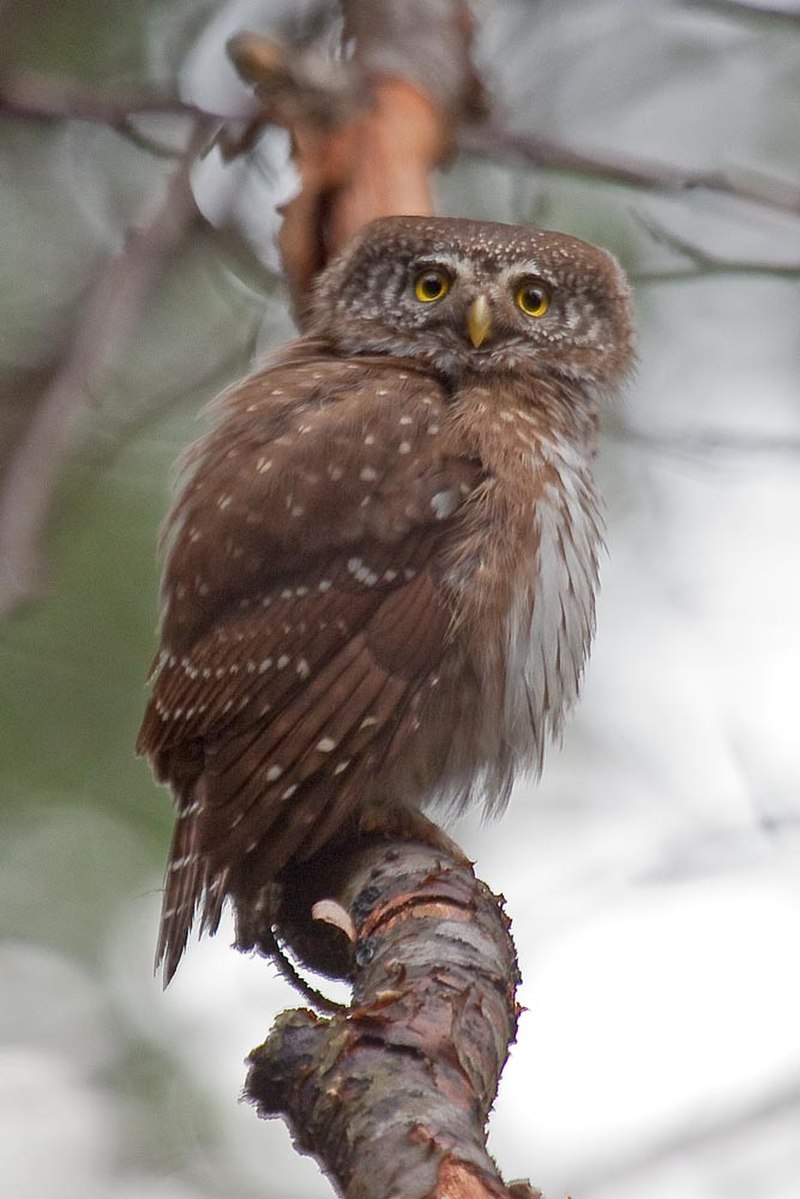
The Eurasian pygmy owl is an adorable, tiny bird species native to the boreal forests of Northern and Central Europe as well as Siberia.
It has a distinct dark reddish-grey brown coloration with spotted sides and half white ring around its neck.
These birds are considered sedentary, meaning that adult populations will remain in their range for most of the year except during seasonal migrations or dispersals.
They prefer coniferous woodland habitats where they can hunt small prey like insects, lizards and rodents from perches located on tree branches or trunks.
During breeding season male pygmy owls have been observed performing aerial displays involving jumps from one branch to another while calling out loudly in order to attract potential mates.
Scientific classification:
| Kingdom | Animalia |
| Phylum | Chordata |
| Class | Aves |
| Order | Strigiformes |
| Family | Strigidae |
| Genus | Glaucidium |
| Species | G. passerinum |
24. Eurasian Hoopoe
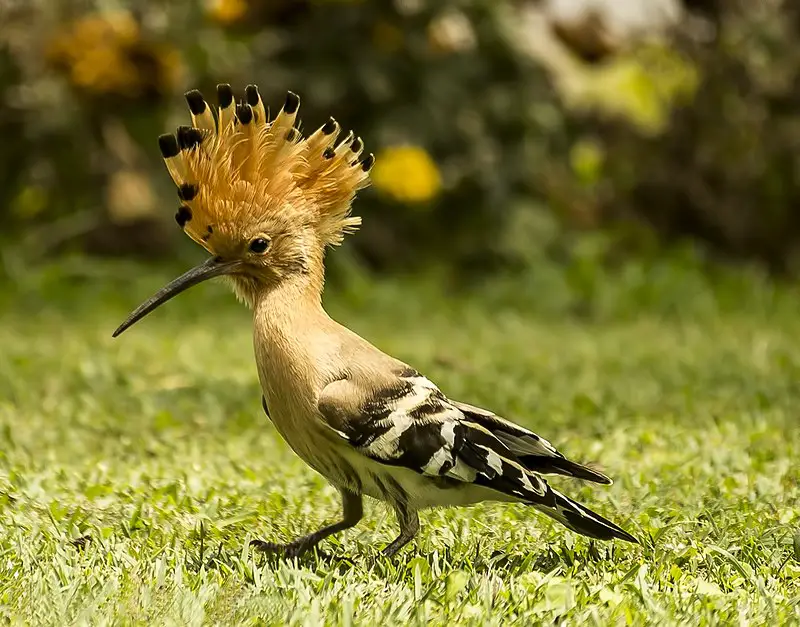
The Eurasian hoopoe is a unique and stunning bird. Its cinnamon-coloured body contrasts sharply with its black-and-white wings, while the tall erectile crest gives it an even more distinctive appearance.
It also has a broad white band across its black tail and a long narrow downcurved beak. When you hear this species of birds call, it’s typically “oop-oop-oop”, very soft yet unmistakable in tone.
This beautiful creature can be found throughout Europe, Asia and northern Africa where they mainly migrate for cooler climates during winter months.
The Eurasian hoopoe is truly one of nature’s most majestic creations – from their vibrant plumage to their mellow calls – making them unforgettable creatures that will never cease to amaze us all.
Scientific classification:
| Kingdom | Animalia |
| Phylum | Chordata |
| Class | Aves |
| Order | Bucerotiformes |
| Family | Upupidae |
| Genus | Upupa |
| Species | U. epops |
25. European Bee-Eater
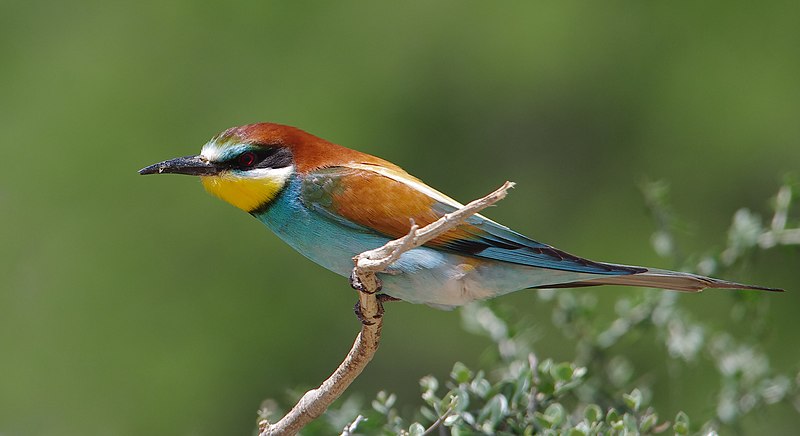
The European Bee-Eater is a stunningly beautiful bird, boasting an array of bright colors. Its head and neck are light blue with greenish ear coverts and its back is chestnut brown.
The wings have yellow primaries bordered in black, while the rest of the feathers contain hues of pink, russet orange, grayish-blue and olive green.
This species can be found breeding throughout Southern Europe to Central Asia as well as Northern Africa to South Africa where it likes to inhabit open country near rivers or streams with bare banks for nesting purposes.
It migrates during winter months down into tropical areas within both Africa and India but will occasionally overshoot northwards which may result in rare sightings elsewhere on occasion too.
Scientific classification:
| Kingdom | Animalia |
| Phylum | Chordata |
| Class | Aves |
| Order | Coraciiformes |
| Family | Meropidae |
| Genus | Merops |
| Species | M. apiaster |
Also Featured In: Most Common Romanian Birds, Birds that Live in Croatia
26. Eurasian Coot
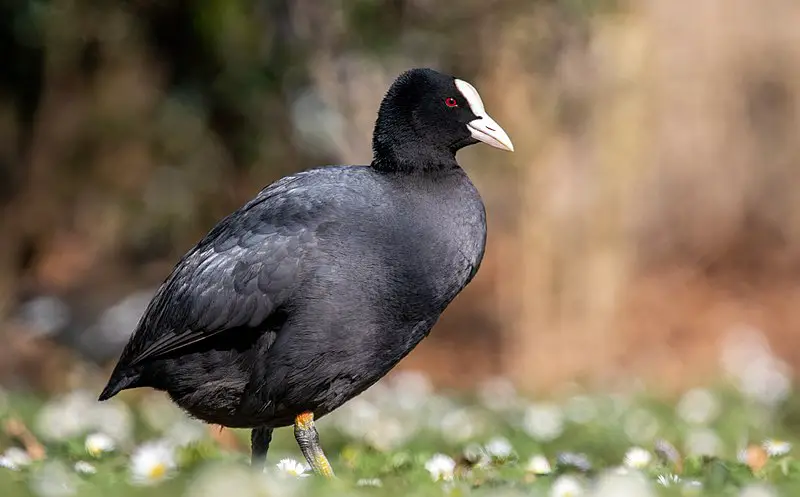
The Eurasian Coot is a water bird belonging to the Rallidae family. It has an overall slaty-black body with a glossy black head and white bill, along with a white frontal shield.
Both male and female coots look similar in appearance. This species can be found across Europe, Asia, Australia, New Zealand and parts of North Africa – making it quite widespread.
In terms of behavior they usually feed on aquatic plants as well as insects while swimming or walking on land near bodies of water such as ponds or lakes.
They are also known for their aggressive nature when defending nesting sites from other birds during breeding season.
Scientific classification:
| Kingdom | Animalia |
| Phylum | Chordata |
| Class | Aves |
| Order | Gruiformes |
| Family | Rallidae |
| Genus | Fulica |
| Species | F. atra |
Also Featured In: Water Birds Live around Us, Birds that Commonly Found in Pond
27. Western Jackdaw
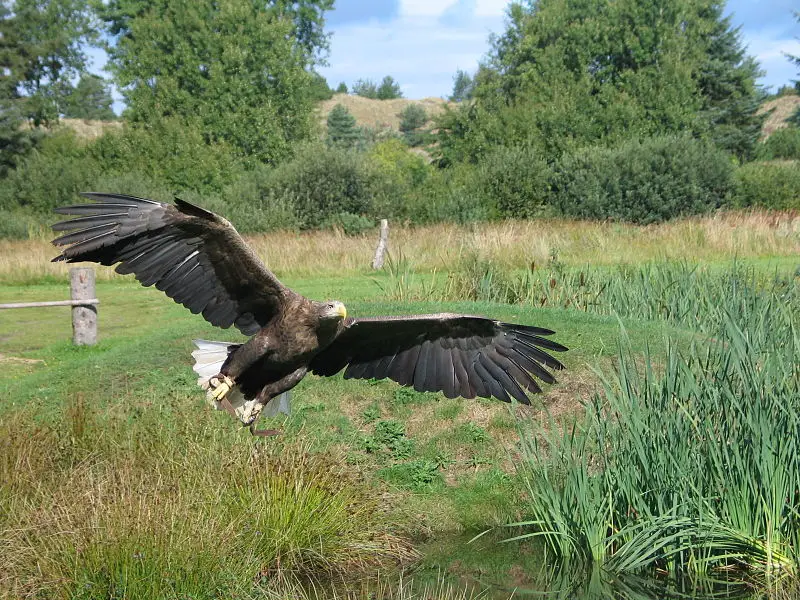
The Western Jackdaw is a species of bird found across Europe. It has glossy black feathers and bright yellow eyes, giving it an attractive appearance. They are highly social birds that live in flocks or colonies around human habitations such as farm buildings and churches, where they can find shelter from the elements.
The diet of these birds consists mainly of grains, insects, small fruits and invertebrates which are scavenged for on open ground or plucked from trees.
These adaptable creatures may also occasionally feed on carrion or steal food from other animals’ nests. Despite being largely insectivorous during breeding season, their diet changes to include more grains when winter arrives due to higher availability in this form at this time of year.
They communicate through various calls including caws and ‘chink-chinks’ used between pairs whilst courting each other before mating season begins in April each year; nest sites will be chosen soon after with the female taking sole responsibility for incubation duties while the male brings her food throughout her shifts.
28. Common Cuckoo
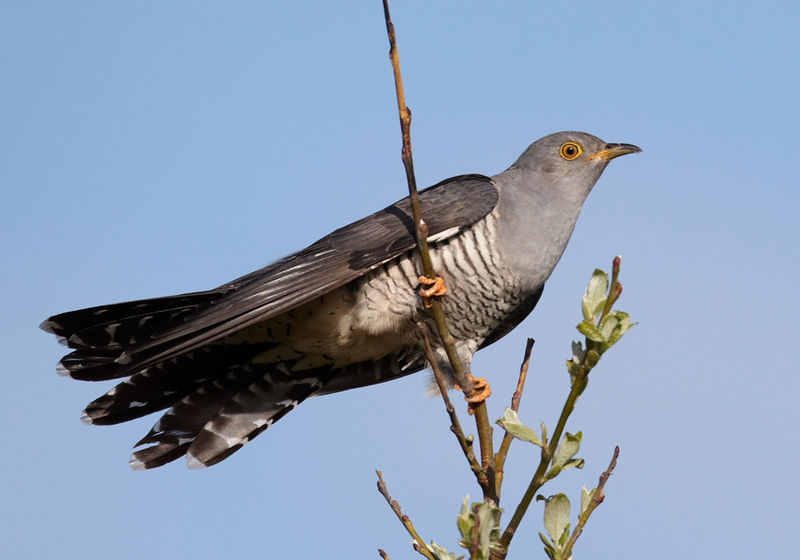
The Common Cuckoo is a medium sized bird belonging to the cuckoo family. It is found in Europe and Asia during summers, migrating to Africa for wintering.
This species has adapted an interesting lifestyle of being a brood parasite – it lays its eggs in other birds’ nests most often that of dunnocks, meadow pipits and reed warblers.
The host bird then incubates the egg as if it were their own which hatches earlier than any other chicks present there thus gaining more attention from the parent birds resulting in better growth rate for Common Cuckoo chicks who are bigger than even their hosts.
Scientific classification:
| Kingdom | Animalia |
| Phylum | Chordata |
| Class | Aves |
| Order | Cuculiformes |
| Family | Cuculidae |
| Genus | Cuculus |
| Species | C. canorus |
29. Corn Crake
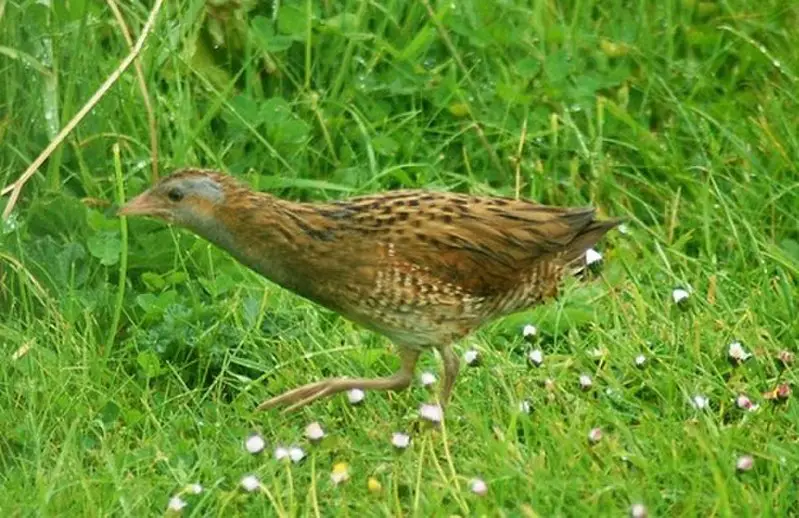
The Corn Crake is a species of rail that inhabits Europe and Asia, migrating to Africa for the winter.
It’s medium-sized with buff or grey streaked brownish black upperparts and blue-grey underparts that are decorated with rust colored bars along its flanks and undertail.
They prefer moist meadows, grasslands, marshes, bogs and moorland where they can find their food sources such as seeds, leaves shoots insects worms spiders etc.
In the summer it may be heard singing from tall vegetation at night when looking for mates but during day time it will hide in thick cover making them difficult to spot.
The corn crake has been listed by IUCN as near threatened due Conservation efforts have helped increase numbers but ongoing threats such as habitat loss still remain an issue so continued effort must be made if this unique bird is to survive into future generations.
Scientific classification:
| Kingdom | Animalia |
| Phylum | Chordata |
| Class | Aves |
| Order | Gruiformes |
| Family | Rallidae |
| Genus | Crex Bechstein, 1803 |
| Species | C. crex |
Also Featured In: Birds of Latvia, Most Common Scotland Birds
30. Stock Dove
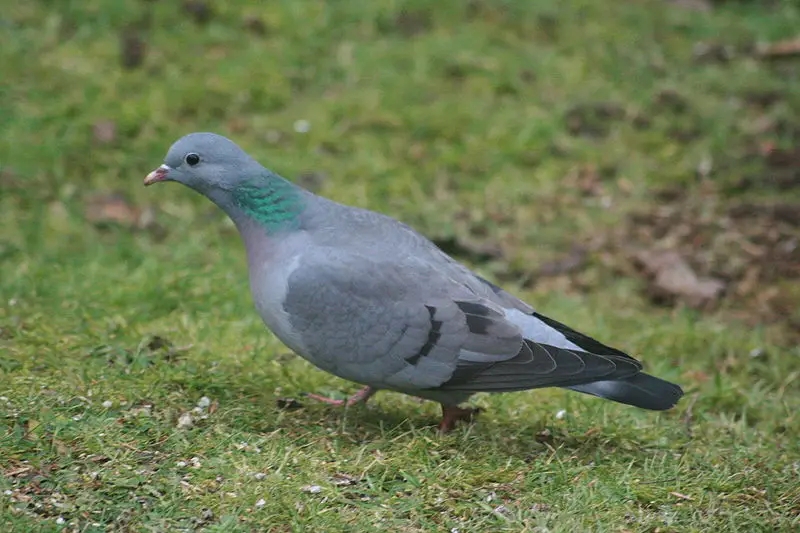
The Stock Dove is a species of bird in the Columbidae family, commonly found across the western Palearctic.
It was first documented by Swedish Naturalist Carl Linnaeus as part of his Systema Naturae publication back in 1758 and given its scientific name – Columba oenas.
Its body has an overall grey-blue colouration with darker wings, while they sport a small white patch on their neck and dark spots along their chest area.
They mainly feed on seeds but can also be seen eating insects or other invertebrates during summertime.
These birds are often heard before being spotted due to their loud cooing sound which echoes through woodlands near lakes and rivers where they typically nest; either low down in trees or sometimes even inside caves.
Scientific classification:
| Kingdom | Animalia |
| Phylum | Chordata |
| Class | Aves |
| Order | Columbiformes |
| Family | Columbidae |
| Genus | Columba |
| Species | C. oenas |
Also Featured In: Lebanon Birds Live in Semi-Desert Areas, Common Birds in London
31. European Turtle Dove
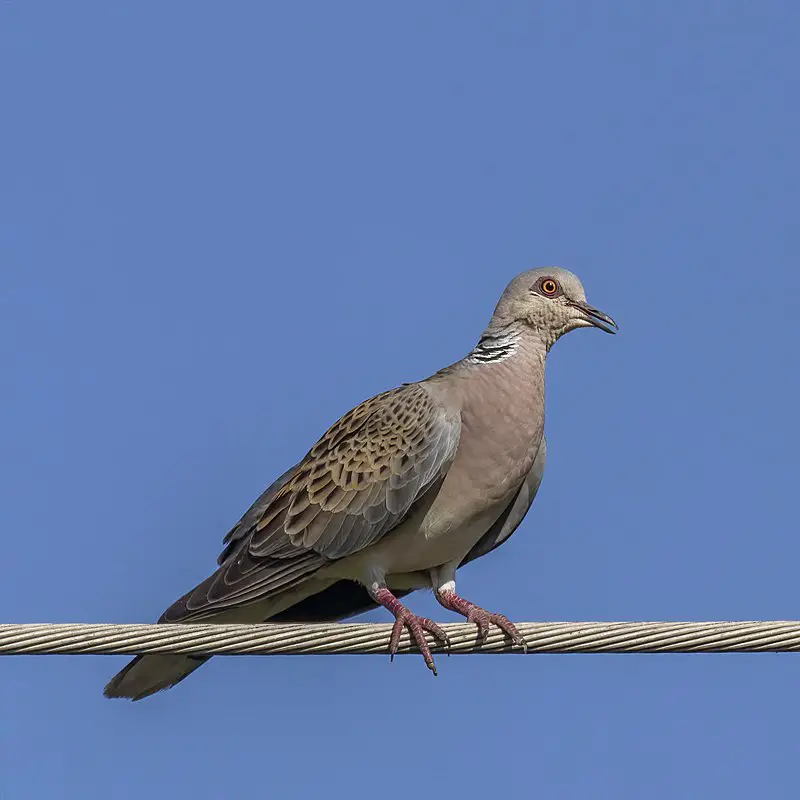
The European turtle dove is a beautiful bird belonging to the Columbidae family of doves and pigeons. It has a wide range across south western Palearctic, including northern Africa, but migrates to sub-Saharan Africa in winter.
The species was officially described by Carl Linnaeus in 1758 as part of his Systema Naturae. This small yet elegant creature can be recognized by its distinctive reddish-brown color with black spots on its wings and tail feathers.
Its underparts are yellowish white while it’s back is grey with dark streaks that run through it making for an attractive patterned plumage.
They feed mainly on grains found on grasslands or near roadsides and have a unique cooing call which makes them easily distinguishable amidst other birdsong.
Scientific classification:
| Kingdom | Animalia |
| Phylum | Chordata |
| Class | Aves |
| Order | Columbiformes |
| Family | Columbidae |
| Genus | Streptopelia |
| Species | S. turtur |
32. Water Rail
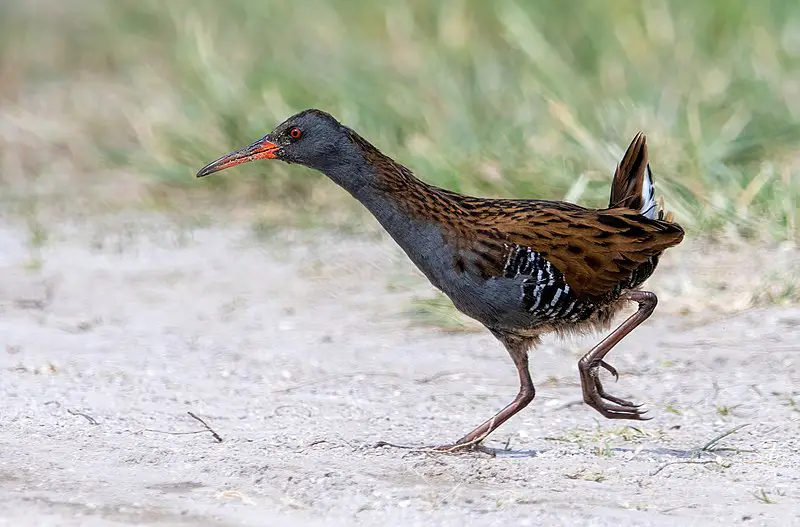
The Water rail is a member of the Rallidae bird family, which inhabits wetlands with dense vegetation. It has a flattened body to aid it in its wetland habitat; this helps it move through long grass and reeds easily.
Adults measure 23-28 cm (9-11 inches) in length and they can be found throughout Europe, Asia and North Africa.
Northern and eastern populations are migratory whereas southern ones remain permanent residents year round.
The bird’s diet consists mainly of insects, small fish, worms, molluscs as well as some plant material like grains or seeds.
Its feathers have an overall brownish grey colouration while its belly is white or creamy yellow with dark markings around the edges of each feather that gives them camouflage against their environment when seen from above or below water level respectively.
Scientific classification:
| Kingdom | Animalia |
| Phylum | Chordata |
| Class | Aves |
| Order | Gruiformes |
| Family | Rallidae |
| Genus | Rallus |
| Species | R. aquaticus |
Also Featured In: Ukrainian Birds You Should Know, Most Common Spain Birds
33. Little Crake
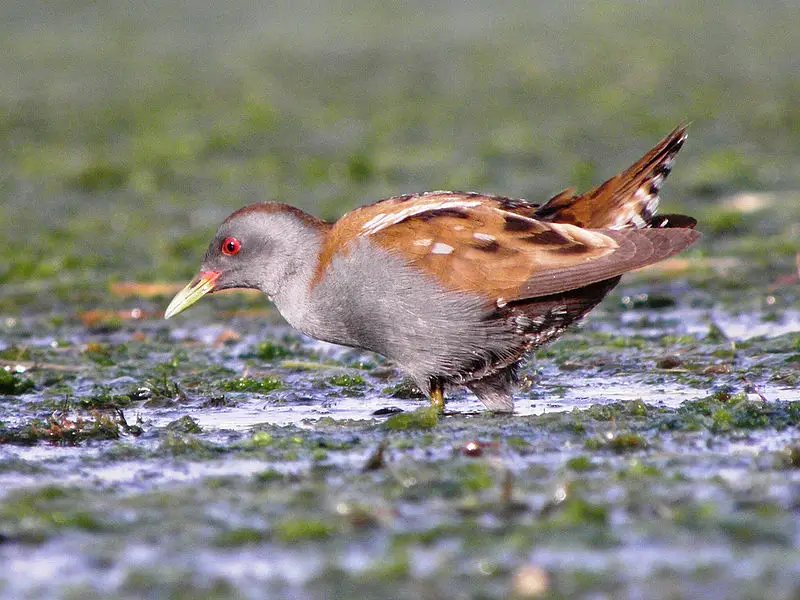
The Little Crake (Zapornia parva) is one of the smallest waterbirds in the family Rallidae. It breeds mainly in reed beds found throughout Europe and western Asia, migrating to Africa for winter months.
Measuring 17-19 cm long, these birds are slightly smaller than their close relative – the Spotted Crake – which can be identified by its lack of spots on its back.
With brown plumage, black eyes and a bill that curves downwards at tips; they also have yellow legs and feet as well as white underparts with some barring towards their underside.
They feed mainly on small invertebrates and insects while nesting near lakes or pools among dense vegetation such as sedges and bulrushes where they lay 4–7 eggs between May to July each year.
Scientific classification:
| Kingdom | Animalia |
| Phylum | Chordata |
| Class | Aves |
| Order | Gruiformes |
| Family | Rallidae |
| Genus | Zapornia |
| Species | Z. parva |
34. Eurasian Three-Toed Woodpecker
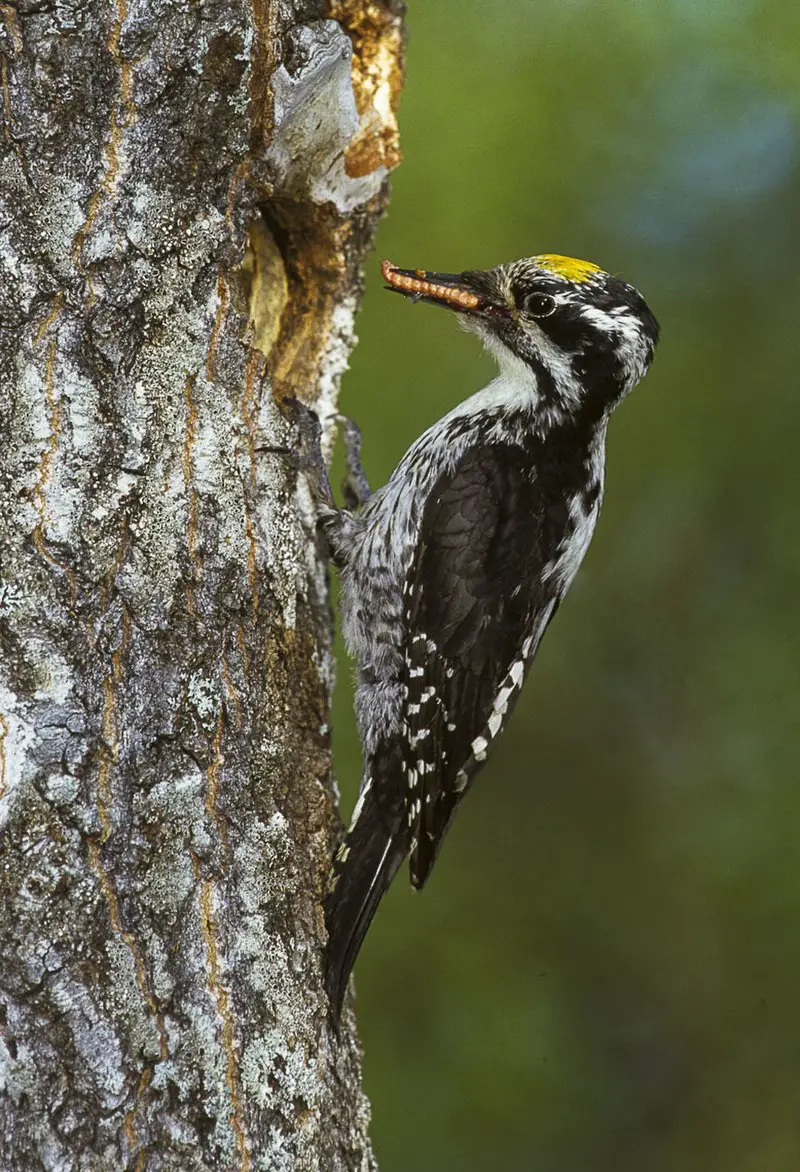
The Eurasian three-toed woodpecker is a beautiful medium sized bird found from northern Europe to Japan.
It was first formally described by Swedish naturalist Carl Linnaeus in 1758 and has since become an iconic species due to its distinctive black, white and red plumage as well as its adaptations for living in cold climates.
The Eurasian three-toed woodpecker lives mainly on coniferous trees such as spruce or fir, where it finds insect larvae under the bark of deadwood which forms part of its diet.
Its most recognizable feature is the bright yellow stripe running down each side of its head, making it easy to identify even at great distances.
This shy but tough creature can survive subzero temperatures with ease thanks to their thick feathers and specialised feet that allow them to cling onto icy branches.
Scientific classification:
| Kingdom | Animalia |
| Phylum | Chordata |
| Class | Aves |
| Order | Piciformes |
| Family | Picidae |
| Genus | Picoides |
| Species | P. tridactylus |
Also Featured In: Birds Commonly Found in Slovenia,
35. Eurasian Jay
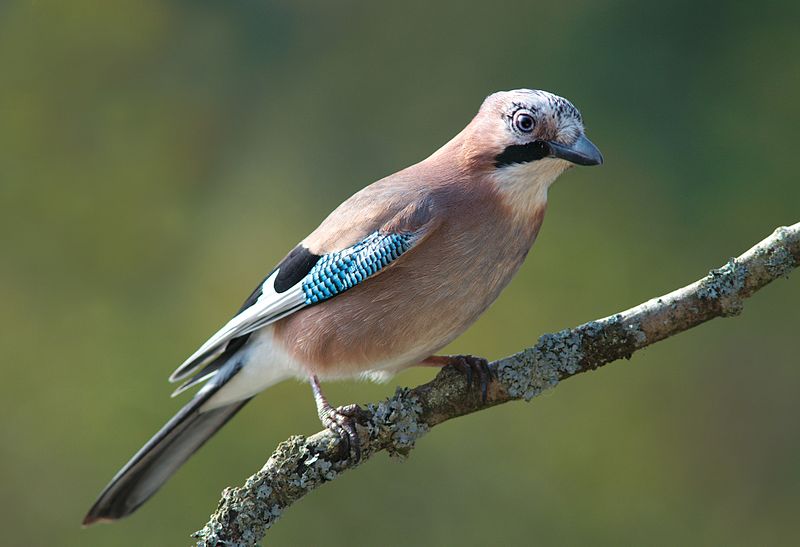
The Eurasian jay is a beautiful passerine bird of the crow family, Corvidae. It has bright pinkish brown plumage with white throat and two black stripes on each side.
The upper wings have an eye-catching blue panel while its tail is all black in color. This species mainly resides in woodlands, spanning over vast regions from western Europe to India and even north-west Africa.
Its diet consists of small invertebrates like insects as well as fruits, seeds and nuts making it quite adaptable when it comes to food sources.
With its loud calls echoing through the forests they inhabit, this amazing creature will definitely make your day brighter if you ever get the chance to spot one.
Scientific classification:
| Kingdom | Animalia |
| Phylum | Chordata |
| Class | Aves |
| Order | Passeriformes |
| Family | Corvidae |
| Genus | Garrulus |
| Species | G. glandarius |
36. Crested Tit
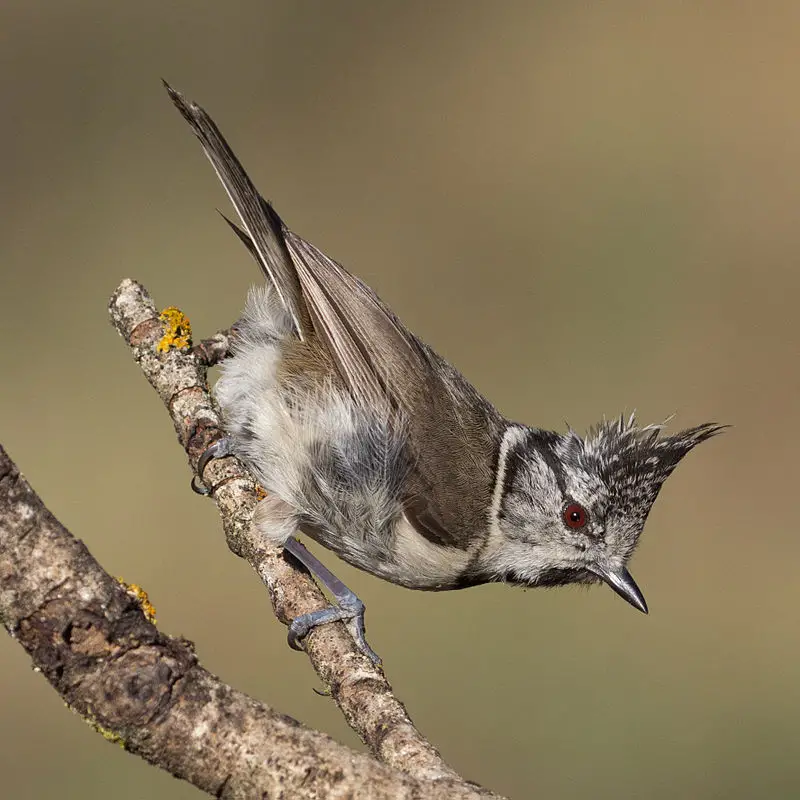
The Crested tit is a beautiful bird found in Europe. It belongs to the family Paridae and its scientific name is Lophophanes cristatus.
This species can be seen mainly in coniferous forests of northern and central Europe, as well as deciduous woodlands of France and the Iberian peninsula.
The most prominent feature of this species is its crest which makes it easily identifiable from other birds in the area. Its diet consists mostly of insects, seeds, berries and nuts – all essential nutrients for their survival.
In Great Britain, they are primarily found inhabiting ancient pinewoods such as Inverness or Straffordshire where you may catch sight of them if you’re lucky.
All-in-all these striking little creatures make an exciting addition to any nature enthusiast’s list – so keep your eyes peeled next time you go out exploring.
Scientific classification:
| Kingdom | Animalia |
| Phylum | Chordata |
| Class | Aves |
| Order | Passeriformes |
| Family | Paridae |
| Genus | Lophophanes |
| Species | L. cristatus |
37. Eurasian Magpie

The Western Jackdaw is a species of bird found across Europe. It has glossy black feathers and bright yellow eyes, giving it an attractive appearance. They are highly social birds that live in flocks or colonies around human habitations such as farm buildings and churches, where they can find shelter from the elements.
The diet of these birds consists mainly of grains, insects, small fruits and invertebrates which are scavenged for on open ground or plucked from trees.
These adaptable creatures may also occasionally feed on carrion or steal food from other animals’ nests. Despite being largely insectivorous during breeding season, their diet changes to include more grains when winter arrives due to higher availability in this form at this time of year.
They communicate through various calls including caws and ‘chink-chinks’ used between pairs whilst courting each other before mating season begins in April each year; nest sites will be chosen soon after with the female taking sole responsibility for incubation duties while the male brings her food throughout her shifts.
38. Coal Tit
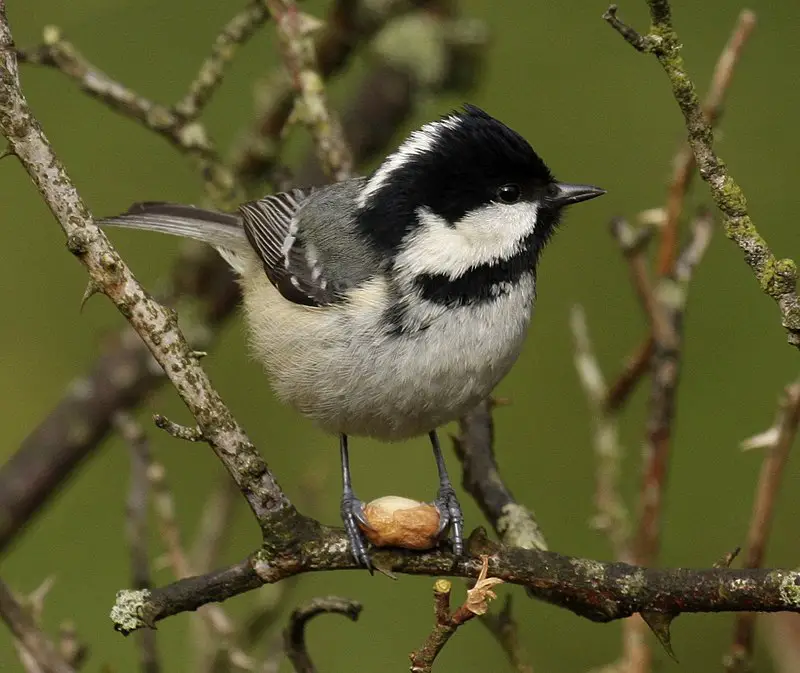
The Coal Tit, also known as the Cole Tit is a small passerine bird belonging to the Paridae family. It has an extensive range, from temperate and subtropical areas in Europe all the way to North Africa.
First described by Carl Linnaeus in Systema Natura back 1758, it’s now commonly grouped with its cousin – The Black-Crested Tit.
This species thrives best when living near forests or other wooded habitats that provide them with plenty of food sources like insects and seeds.
They are considered quite common throughout their range due to their adaptability and resilience which makes them well suited for urban environments too.
Scientific classification:
| Kingdom | Animalia |
| Phylum | Chordata |
| Class | Aves |
| Order | Passeriformes |
| Family | Paridae |
| Genus | Periparus |
| Species | P. ater |
39. Eurasian Wren
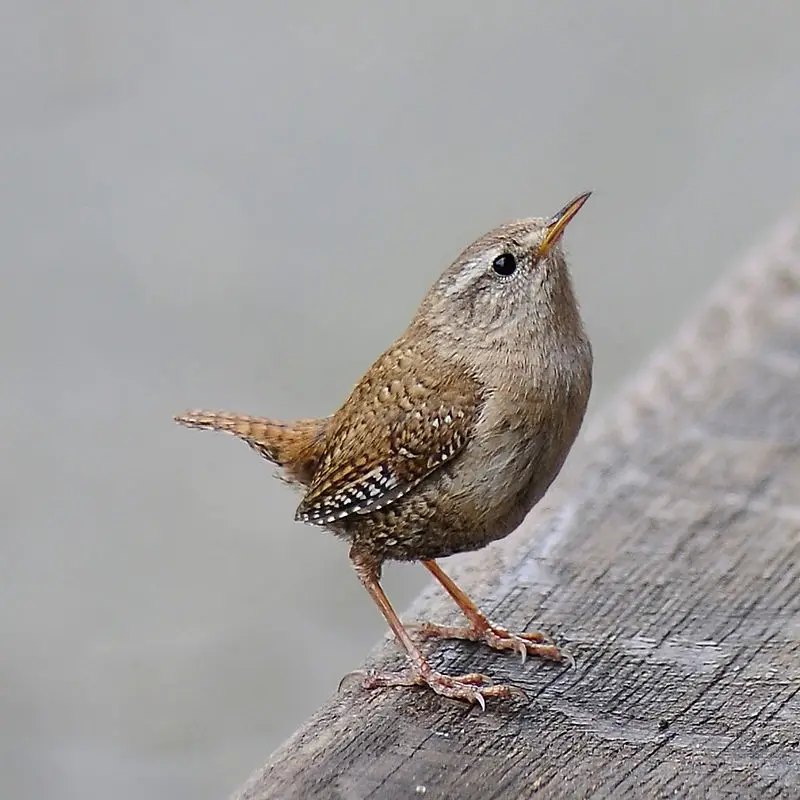
The Eurasian Wren is a small, insectivorous bird that can be found throughout Europe and Africa.
It has russet-brown upperparts with paler buff-brown underparts and its most notable feature is its short tail which it holds upright in flight or when perched.
Its neck is also quite short while the bill tends to be long and thin.
The species prefers dense vegetation like hedgerows, woodland edges and parks as well as coastal areas where there are plenty of insects for them to feed on such as spiders, beetles, caterpillars etc..
Their song consists mainly of high notes that vary between regions but usually ends with four or five repeated trills – making them an easily identifiable addition to any garden.
Scientific classification:
| Kingdom | Animalia |
| Phylum | Chordata |
| Class | Aves |
| Order | Passeriformes |
| Family | Troglodytidae |
| Genus | Troglodytes |
| Species | T. troglodytes |
Also Featured In: European Birds, Yakushima Island Birds You Should Know
40. Ural Owl
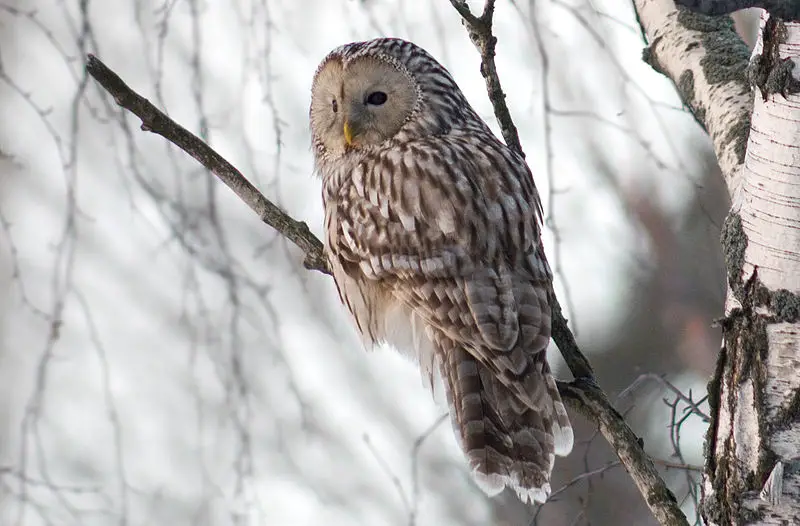
The Ural owl is a majestic nocturnal bird of the Strigidae family. It has an impressive wingspan, usually between 28 to 38 inches wide.
This species can be seen throughout much of Eurasia, from northern Scandinavia and Scotland all the way east across Russia into Korea and Japan; it even reaches southern parts of Mongolia.
The Ural owl sports brown feathers with white spots that help it blend in with its environment during the day making it difficult for predators or humans alike to spot them easily.
These owls also have large yellow eyes which helps them hunt better at night by being able to see their prey more clearly in dim light conditions.
All these features combined make the Ural owl one truly remarkable creature.
Scientific classification:
| Kingdom | Animalia |
| Phylum | Chordata |
| Class | Aves |
| Order | Strigiformes |
| Family | Strigidae |
| Genus | Strix |
| Species | S. uralensis |
Also Featured In: Birds You’ll Find in Hokkaido,
41. White-Tailed Eagle
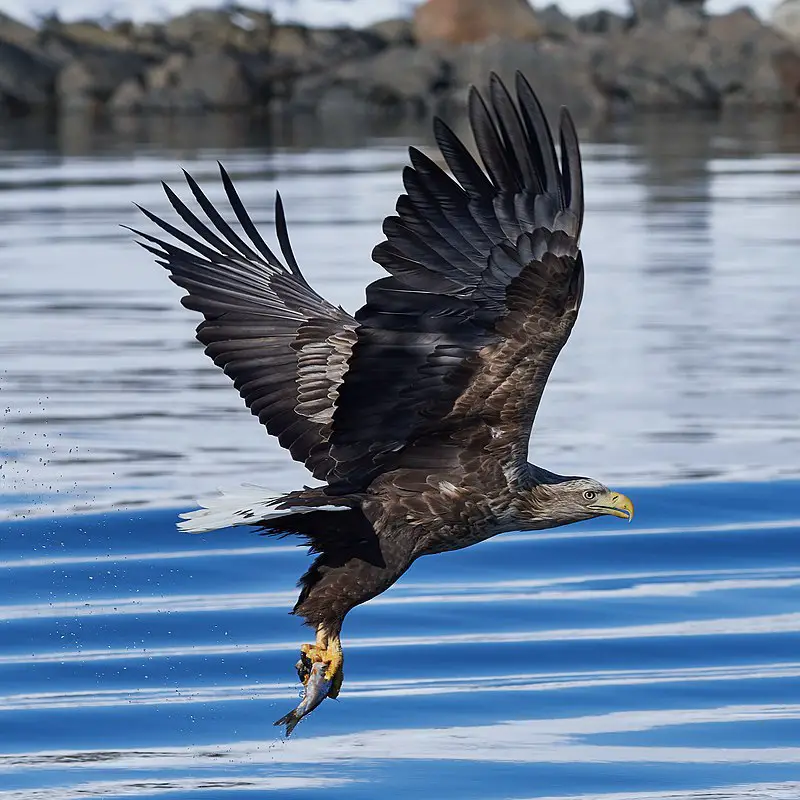
The white-tailed eagle is an impressive species of sea eagle found across temperate Eurasia. This majestic bird belongs to the family Accipitridae, which includes hawks, kites and harriers.
It has a wingspan of up to 2.5 meters and can weigh 4 kilograms or more.
The plumage varies in colour from dark brown above with paler head and neck while its tail is pure white – hence it’s name.
They feed mainly on fish but will also take small mammals, birds and carrion when available.
White-tailed eagles are solitary by nature but form pairs during nesting season typically near bodies of water such as lakes or coasts where they build large stick nests on trees or cliffsides for their young ones to hatch safely in peace.
Scientific classification:
| Kingdom | Animalia |
| Phylum | Chordata |
| Class | Aves |
| Order | Accipitriformes |
| Family | Accipitridae |
| Genus | Haliaeetus |
| Species | H. albicilla |
42. House Sparrow

The house sparrow is a small bird of the Passeridae family. It has an average length of 16 cm and weighs 24-39.5 gm.
Females have dull brown and grey plumage, whereas males are brighter, with black, white and brown markings on their wings and back feathers.
This species is one among 25 different kinds in its genus Passer .These birds are found all around the world mainly near human dwellings where they feed off food scraps from garbage bins or gardens etc..
They also make nests close to houses which makes them even more visible to people living nearby.
House sparrows can be seen hopping around yards looking for food during daytime hours but usually hide in colonies at night time.
Scientific classification:
| Kingdom | Animalia |
| Phylum | Chordata |
| Class | Aves |
| Order | Passeriformes |
| Family | Passeridae |
| Genus | Passer |
| Species | P. domesticus |
43. Larks
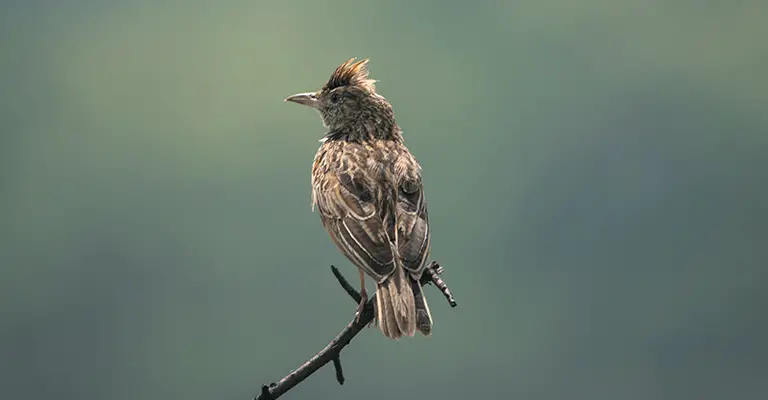
Larks are small passerine birds that belong to the Alaudidae family. These birds have a cosmopolitan distribution and can be found in many different habitats, including dry regions.
The largest number of lark species is located in Africa, while only one species (horned lark) inhabits North America and another one (Horsfield’s bush lark) lives in Australia.
These beautiful creatures usually appear during dawn or dusk as they sing their melodious songs high up into the sky.
Larks possess impressive flying skills which make them capable of reaching heights far above most other bird species.
Despite this skill, they prefer living close to the ground where there are plenty of seeds and insects for them to feed on.
Scientific classification:
| Kingdom | Animalia |
| Phylum | Chordata |
| Class | Aves |
| Order | Passeriformes |
| Superfamily | Sylvioidea |
| Family | Alaudidae Vigors, 1825 |
Also Featured In: Flocks Birds around Us, Native Birds of Kazakhstan
44. Mallard
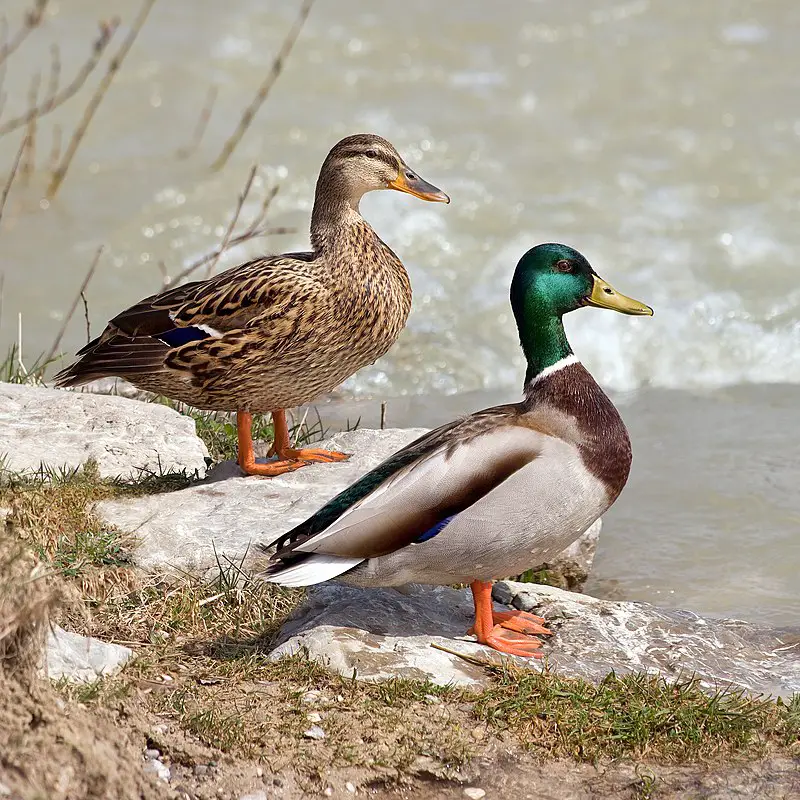
The Mallard is a species of dabbling duck that can be found living in temperate and subtropical regions across the Americas, Eurasia and North Africa.
It has been introduced to other areas such as New Zealand, Australia, Peru, Brazil and South Africa by humans.
This beautiful bird belongs to the Anatinae subfamily of waterfowl family Anatidae. The adult mallards have a glossy green head with white neck ring surrounding.
It along with brownish grey body feathers making them look stunning when they fly away or just sitting in their natural habitat around lakes or ponds.
They are excellent swimmers too due to webbed feet which helps them swim fast underwater while looking for food like aquatic insects etc.. Their loud quacking sound makes them quite popular among nature lovers.
Scientific classification:
| Kingdom | Animalia |
| Phylum | Chordata |
| Class | Aves |
| Order | Anseriformes |
| Family | Anatidae |
| Genus | Anas |
| Species | A. platyrhynchos |
45. Common Raven
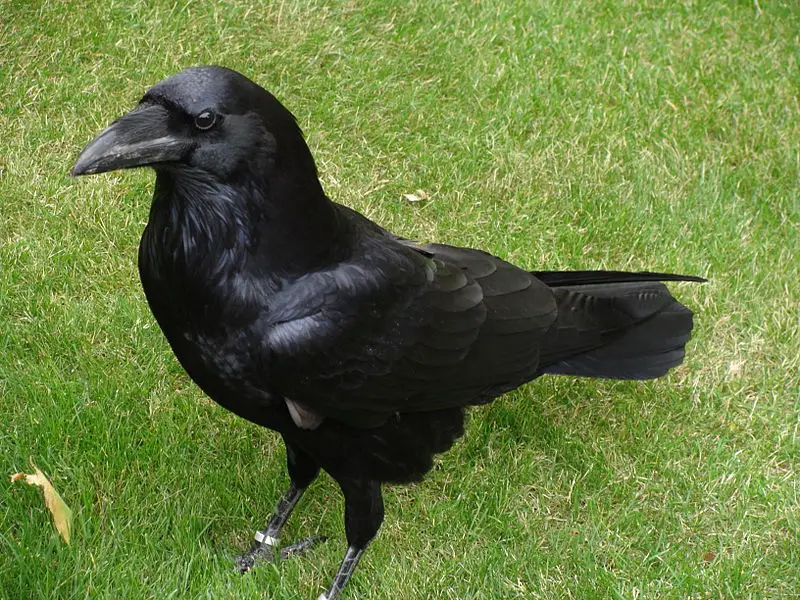
The Common Raven is an iconic black bird found throughout the Northern Hemisphere. It belongs to the Corvus corax species of passerines, and has at least eight subspecies with little physical variation between them.
Recent research however suggests there are significant genetic differences among populations from various areas.
They have a large wingspan of up to 1m and their call can be heard over great distances due to its deep croaking sound; they also use mimicry for communication purposes like many other birds do.
The ravens diet consists mostly of carrion, insects and fruits but they will scavenge in human settlements as well when food sources become scarce.
Their nests require plenty of space so these birds prefer open habitats such as tundra or mountain regions- ideal conditions for their long distance migrations.
Scientific classification:
| Kingdom | Animalia |
| Phylum | Chordata |
| Class | Aves |
| Order | Passeriformes |
| Family | Corvidae |
| Genus | Corvus |
| Species | C. corax |
Also Featured In: Most Common Nature Birds, Birds that Live in San Francisco Bay Area
46. Great Cormorant
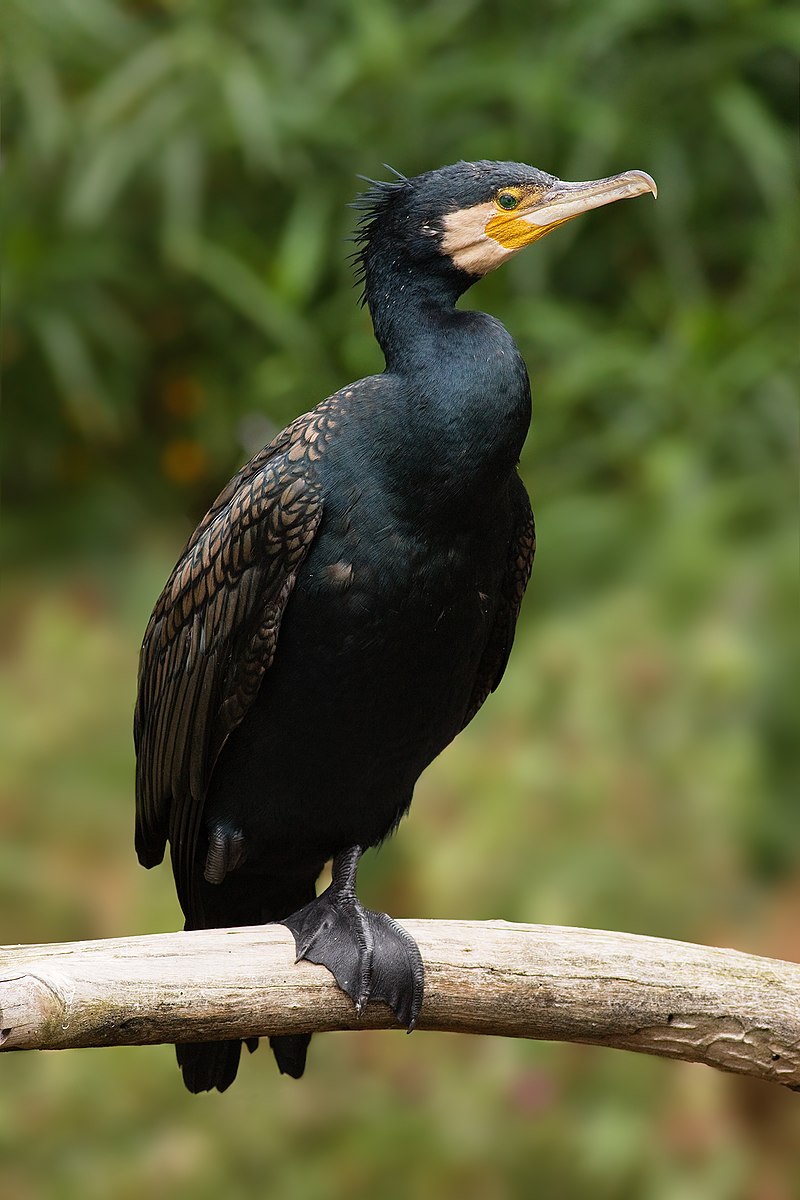
The Great Cormorant is a large seabird belonging to the cormorant family. It has many names, including Black Shag in New Zealand and Large Cormorant in India.
Its striking black feathers make it easy to recognise along coastlines or near bodies of water. The bird can measure up to 1 metre long with a wingspan of around two metres and weighs roughly 3 kilograms.
In flight, its neck is stretched out straight ahead while its bill points downwards – an unmistakable sight for any keen observer.
Cormorants are strong swimmers and excellent divers, frequently going underwater in search of food such as fish or crustaceans that they scavenge from the ocean floor.
They live primarily on coasts but have also been seen inland where there are suitable waterways available – providing another opportunity for nature lovers hoping to catch a glimpse of this impressive species.
Scientific classification:
| Kingdom | Animalia |
| Phylum | Chordata |
| Class | Aves |
| Order | Suliformes |
| Family | Phalacrocoracidae |
| Genus | Phalacrocorax |
| Species | P. carbo |
47. Northern Lapwing
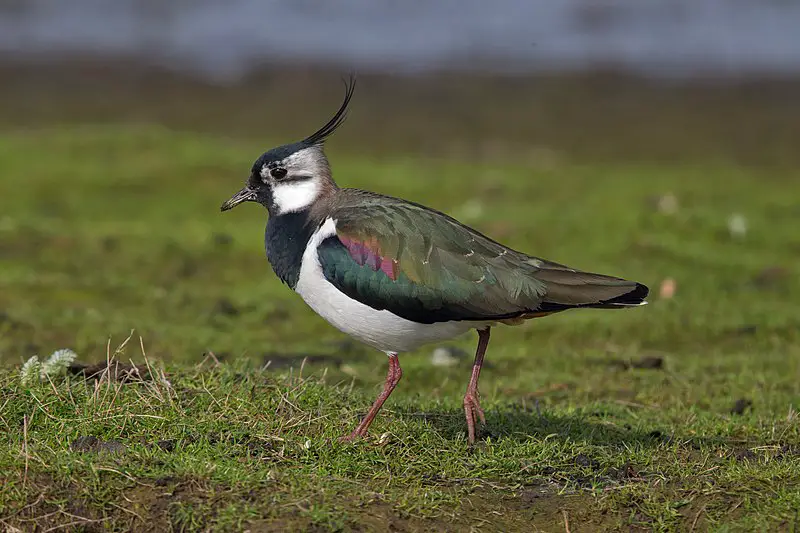
The Northern Lapwing is a beautiful bird found in temperate Eurosiberia. It has several names, such as Peewit or Pewit, Tuit, Green Plover and Pyewipe – all of which describe its unique call that resembles the sound of “peee-wit.”
During winter months it migrates to places like North Africa, India and parts of China.
The adult lapwings are mainly black and white with crest on their heads while juveniles have mottled brown feathers.
They feed on insects which they catch by making a short flight from the ground then hovering briefly before diving back down again.
Their long red legs make them stand out amongst other birds when they walk around looking for food.
A lovely sight.
Scientific classification:
| Kingdom | Animalia |
| Phylum | Chordata |
| Class | Aves |
| Order | Charadriiformes |
| Family | Charadriidae |
| Genus | Vanellus |
| Species | V. vanellus |
48. Common Goldeneye
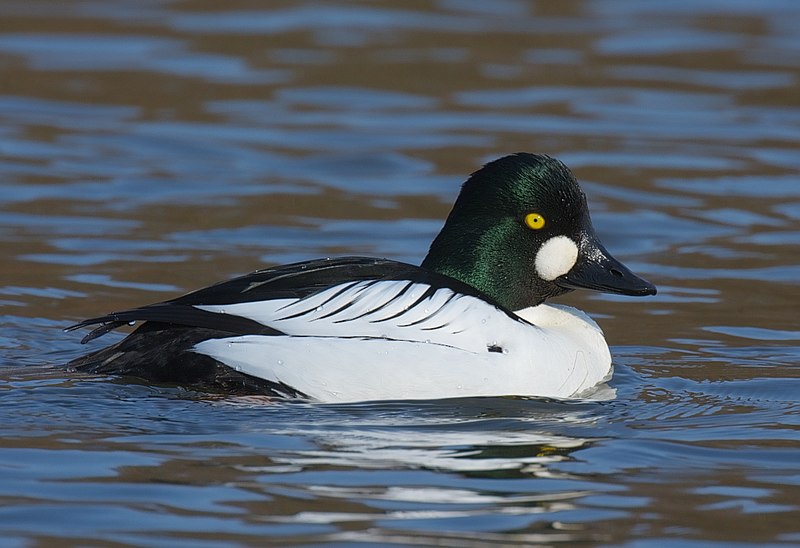
The Common Goldeneye is a medium-sized sea duck from the genus Bucephala. It has an iconic golden eye and bulbous head, which gave it its scientific name – Boukephalos (bullheaded).
This species can be found in many areas of North America, Europe and Asia. They are usually seen swimming alone or in pairs near large bodies of open water such as lakes and rivers.
In addition to their distinctive eyes, they have white wing patches on either side with black spots along the edges – helping them stand out among other ducks.
The diet of these birds includes aquatic insects, mollusks and crustaceans.
During mating season males often perform elaborate courtship displays including head bobbing while producing loud calls that can travel quite far distances across the landscape.
Scientific classification:
| Kingdom | Animalia |
| Phylum | Chordata |
| Class | Aves |
| Order | Anseriformes |
| Family | Anatidae |
| Genus | Bucephala |
| Species | B. clangula |
Also Featured In: Black And White Birds You Don’t Know About, Common Birds in Alberta
49. Aquatic Warbler
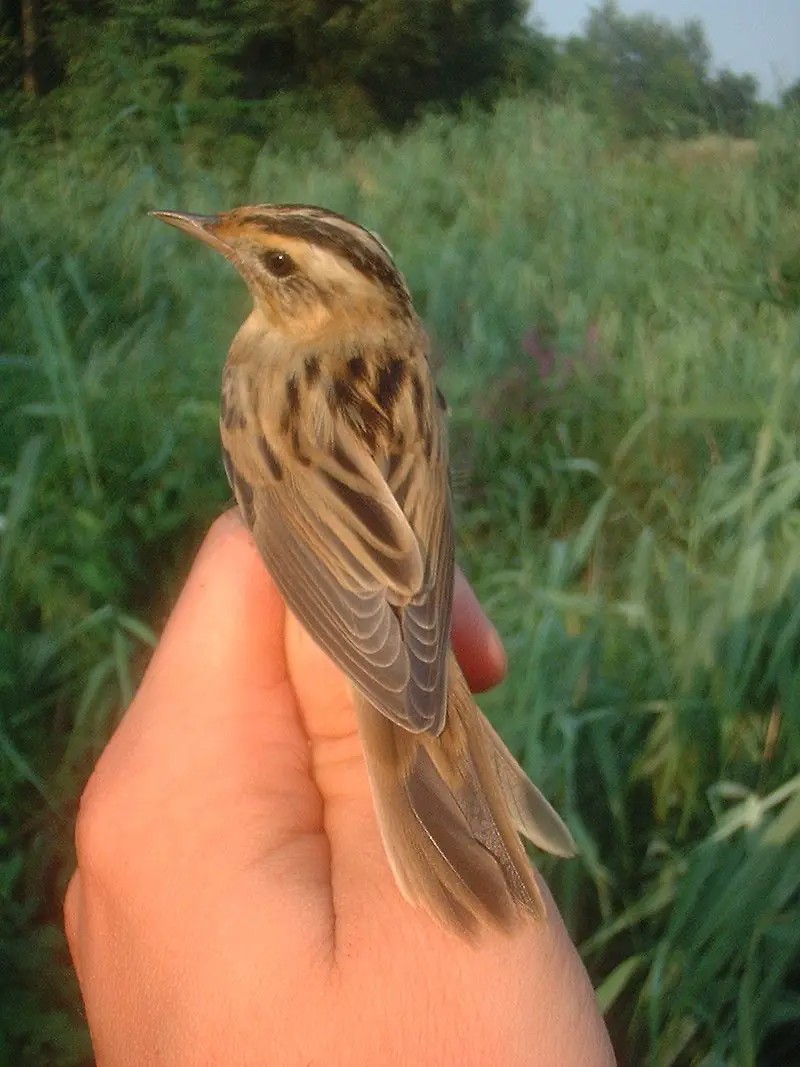
The Aquatic Warbler is a species of Old World warbler that can be found breeding in temperate eastern Europe and western Asia. It has an estimated population of 11,000-15,000 pairs.
This bird migrates during winter to west Africa where it spends its time until the spring months when it returns for the summer season.
Its exact whereabouts were unknown for many years but researchers eventually located them at Djoudj National Bird Sanctuary near Mauritania on the edge of the Sahara Desert.
They prefer wetland habitats such as marshes with dense reed beds which offer a suitable environment to nest and feed their young successfully each year.
With conservation efforts this species will hopefully continue to thrive in its natural habitat over coming years.
Scientific classification:
| Kingdom | Animalia |
| Phylum | Chordata |
| Class | Aves |
| Order | Passeriformes |
| Family | Acrocephalidae |
| Genus | Acrocephalus |
| Species | A. paludicola |
50. Common Snipe
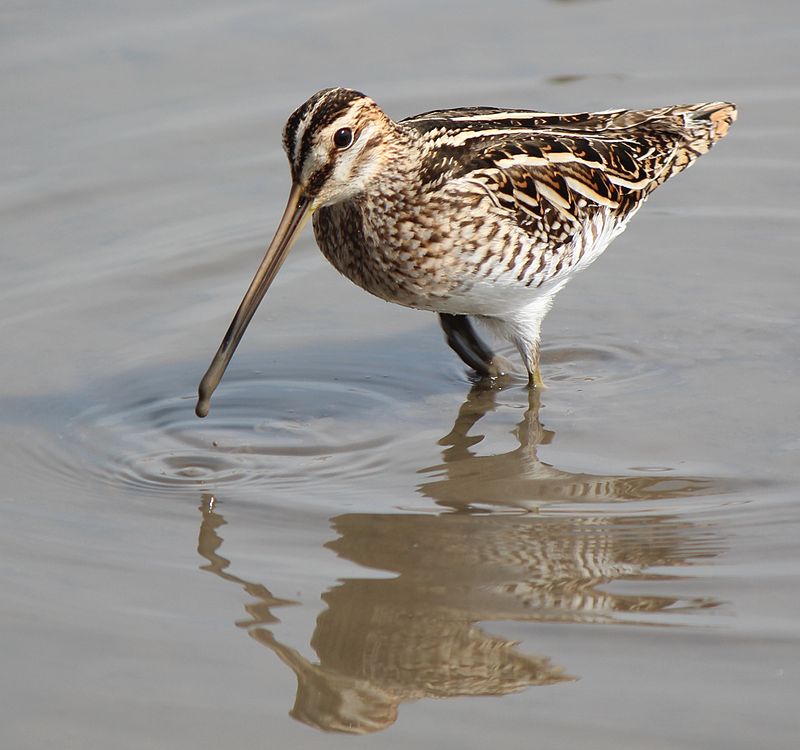
The Common Snipe is a small wader bird that can be found throughout the Palearctic region, from Iceland to northern Russia and Siberia. It breeds in marshes, bogs, tundra and wet meadows during summertime.
Its diet consists of earthworms and insects which it finds by probing with its long bill into soft ground.
During winter months they migrate southwards in search of more favourable conditions for breeding; however their exact migration routes remain unknown.
These birds are fairly secretive but can often be seen skulking around wetlands using their cryptic mottled brown plumage as camouflage against predators.
They have an unmistakable flight pattern – rapid bursts of wing-beats interspersed with glides – making them one of the most distinctive species on our planet.
Scientific classification:
| Kingdom | Animalia |
| Phylum | Chordata |
| Class | Aves |
| Order | Charadriiformes |
| Family | Scolopacidae |
| Genus | Gallinago |
| Species | G. gallinago |